UJJAIN – A city in the Indian state of Madhya Pradesh considered among the holiest of cities by Hindus. One of the 4 places in India where the Kumbh Mela is held once in 12 years. Ujjain is also known as the City of Mahakal, one of the most prominent jyotirlings. It can be safely said that the economy of Ujjain is built around its religious places more, specifically the Temple of Mahakal to which pilgrims and tourists throng from far and near. More so, after the Central government gave the temple a fresh makeover and also built the magnificent 900 metre-long Mahakal corridor.
First, the historical significance and legend surrounding Mahakal. When was the temple first built is difficult to say, though it is assumed the temple dates back to pre-historic times. Religious texts of the 6th century BC mention Mahakal as does Kalidasa later in his works. Successive Hindu dynasties that ruled Ujjayani or Avantika, as it was then called, all paid obeisance to Mahakaleshwar and made extensive contributions/additions to the temple. After being destroyed and looted by Islamic invaders, the temple was rebuilt in the 12th century AD by King Udyaditya and further additions were made by the Maratha rulers.
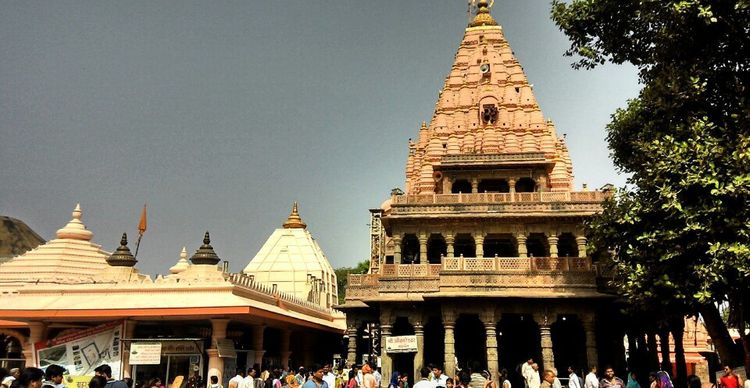
The temple has five levels with one level said to below ground. The third level houses Nagaparameshwar and is open to the public only on Nagpanchami day. Mahakal is the only jyotirling that faces south, while the rest face east. Why? Because, South is said to be the direction of Death and Mahakal, being the Lord of Time, if He blesses you, you can challenge death and disease. Legend has it that King Chadrasena was an ardent devotee of Shiva. A small boy Shikhir too wanted to pray with him in the palace but was thrown out by the guards. As he sat praying on the on the banks of the River Shipra, he heard enemies of the king planning to attack the city supported by a demon named Dushan. Shikhir ran to Vridhi, a priest and narrated this to him and both prayed fervently to Shiva. Pleased, Shiva assumed the form of Mahakal and in a rage demolished all the adversaries of the king including Dushan. He was requested by His devotees to stay in the kingdon. He agreed and manifested Himself as a jyotirling.
Having heard and read a lot about Mahakal, it was my desire that on my birthday, I have a darshan of His, in Ujjain. Off we flew to Indore, landed in Ahilyabai Holkar airport, an hour later than scheduled. The car was waiting for us and in an hour, we had reached Meghdoot Resort in Ujjain. A good place that had seen better times, now losing out to younger, newer hotels and resorts. Freshened up, we checked with our driver-cum-guide, if all the noted sites in Ujjain could be done in a day. He assured us it was possible and said the first visit will be, of course to Mahakaleswar Temple. Our driver enquired if we were interested in the ‘Bhasma Aarti’, that takes place at around 4.30 AM and devotees have to line up by 1.30 AM. He said, even though tickets had to be booked in advance, he could arrange entrance through some pandits for a fee of Rs.2500 per head. What is Bhasma Aarti? The lingam is washed and then an abhishek performed using ash that was originally taken from crematoriums. These days it is only holy ash and this aarti is said to be the highlight of Mahakal temple. We politely declined the offer, citing the long journey to be made the following day. Soon we got off the main road to take the turn towards the temple entrance, when we were stooped by the usual tricksters directing us to the parking lot, a kilometer away forcing us to walk OR, pay them a ‘ convenience fee ‘ and they would allow the car to be parked on the road near the temple. Our driver, being a local said we were not going to the temple but beyond to Narsingh Ghat. we were allowed to pass.
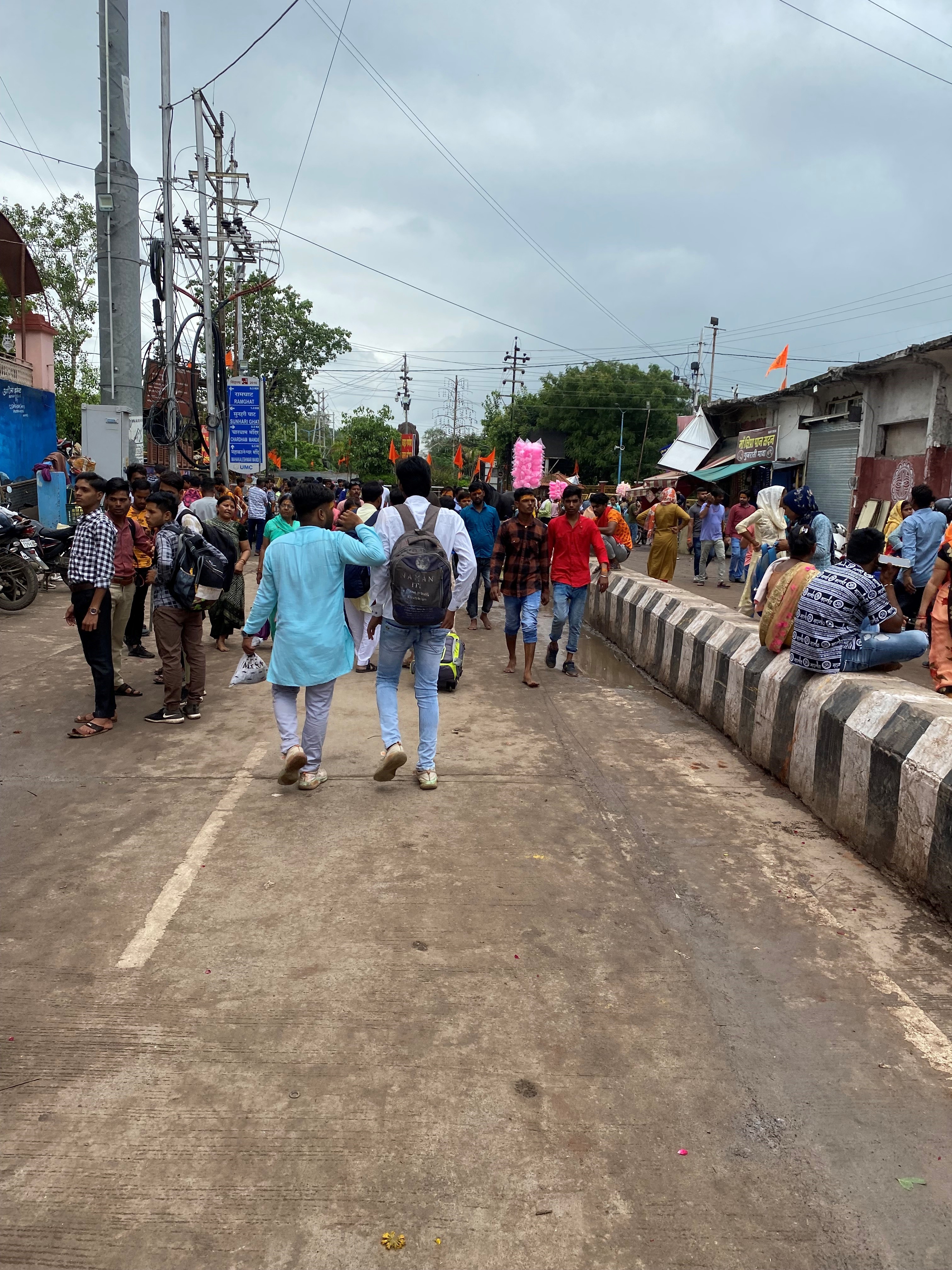

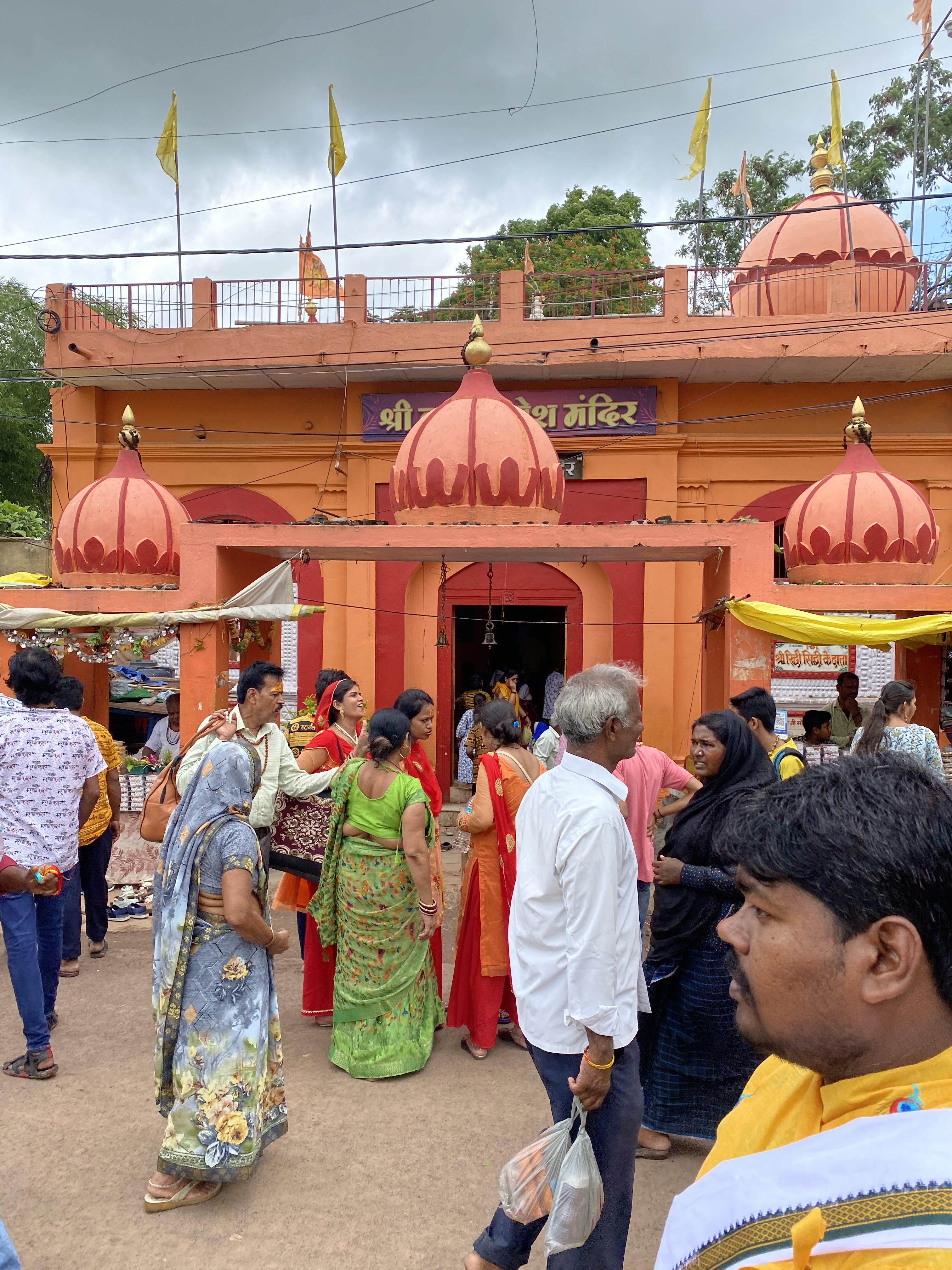
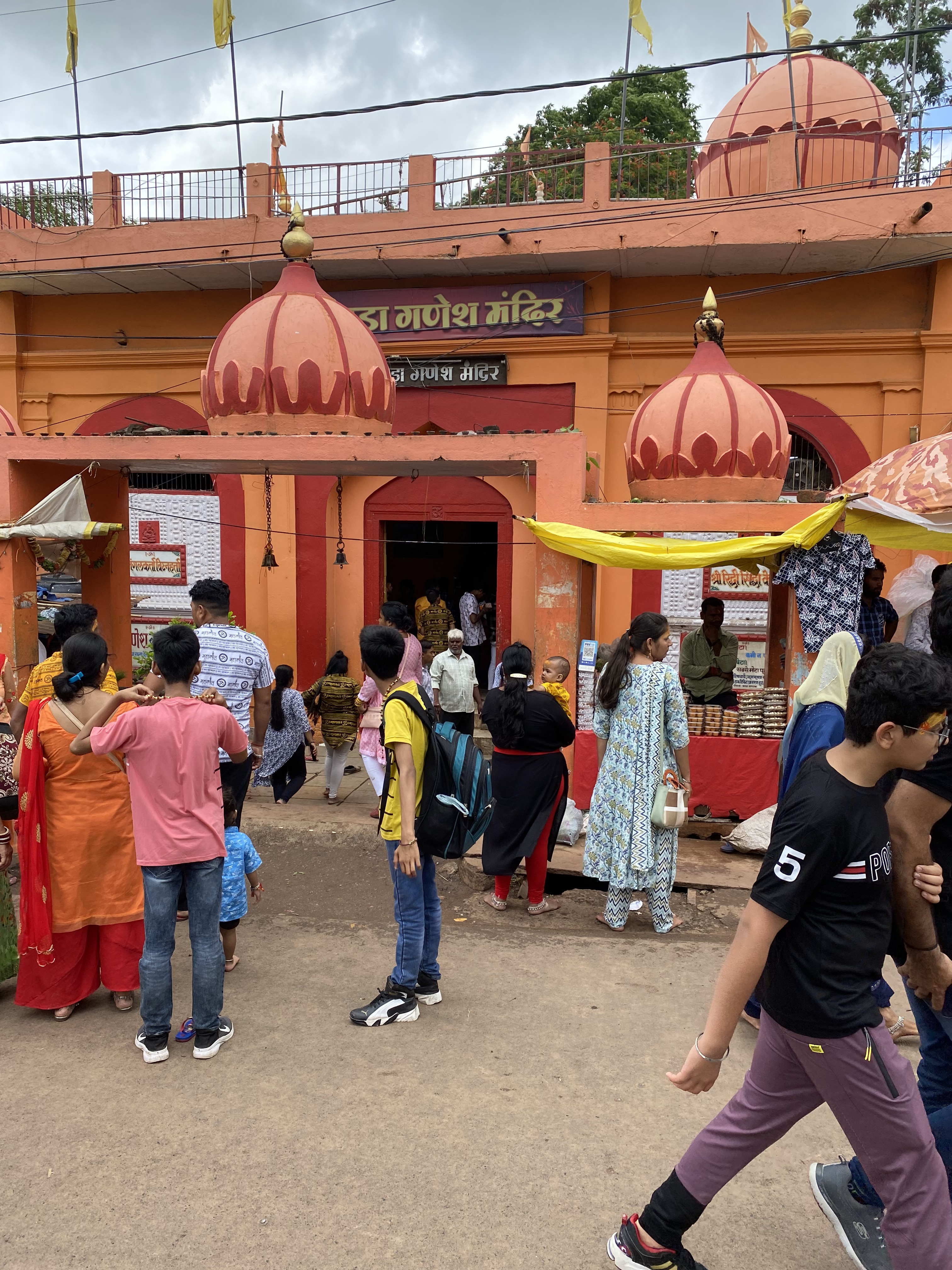
Wife wanted to visit the Bada Ganesh Mandir first. I said, let us have darshan of Mahakal first and directed the driver to park near the ‘Sheeghra Darshan counter’ or special darshan, for which the cost was Rs.250 per head. Mobile phones and other electronic items are not allowed inside the temple, so we dutifully handed them over to our driver before proceeding to but special darshan tickets. Imagine my shock, when I found the counter closed and the person sitting behind the counter counting cash. A gentle knock at the counter and I was told no more special darshans for the day. I pleaded with him for 2 tickets but to no avail. He asked us to check around 4.30 PM and if not to come tomorrow. Tomorrow? All our plans will be defeated. Our driver suggested that we try the common darshan that could take anywhere upto 3 hours. No choice, so we trudged back towards the common darshan entrance, passing the Bada Ganesh Mandir again. Now that we were on foot, decided to have Ganesh darshan. Not much crowd. What a sight! An enormous and benevolent Ganesh or Ganpati! Sought His blessings for a good darshan of His Father, Mahakal.
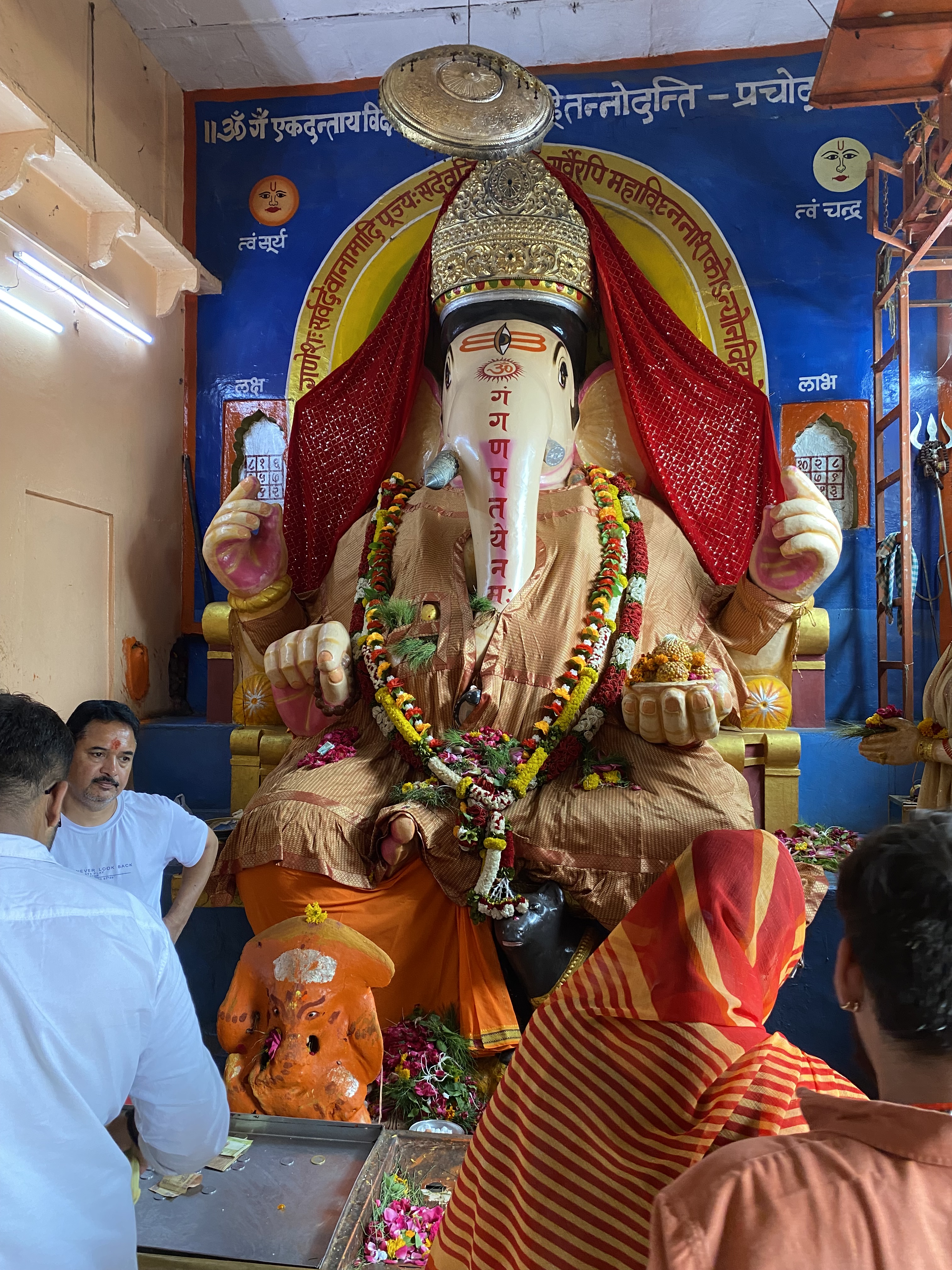
Made our way towards the common darshan of Mahakal. A few hundred meters of walking and we were at the entrance to the magnificent temple. As we entered, we saw that there was no line but a number of people were walking briskly/running up an inclined passage to the chants of ‘Bam Bam Bole’ & ‘Jai Mahakal’. We too quickened our steps and to our side below could see a massive modern hall with dividers for serpentine lines of pilgrims. It was empty today and we were straightaway allowed up the incline. Further up we went and the chants grew even louder. Karthikeya Mandapam -said the board as we admired the clean, well-maintained temple. Now we were moving downwards and could see Ganesh Mandapam, as the chants now grew to a crescendo. Moved down a little further and the people now moving in a line were moving slowly now. Nandi Mandapam……. and all of a sudden we were in front of Lord Mahakal in all His glory. We were looking at the lingam from a distance as Garba Griha darshan is not allowed on all days. A well-decorated and well-lit garba griha with the lingam in a silver surrounding was awe-inspiring. A solitary priest was inside. What is more, there is a giant TV screen on which one can see, up close the garba griha. We were now moving towards the exit, when we were accosted by two priests who inquired if we wanted to perform abhishek. We politely declined and soon we were out in the sunshine. The darshan had taken us 25 minutes. Truly blessed to be before Mahakal on my birthday and sent a silent thanks to Bada Ganesh for facilitating the darshan. We passed a portion of the Mahakal corridor, where we decided we would come in the evening, when it would be lit-up.
Our driver was surprised at our quick return and we drove around half a kilometer to Harsiddhi Temple, one of the Shaktipeeths. When Shiva was carrying the burning body of Sati, her elbow fell in this place. It is also said that when Shiva and Parvati were alone in Kailash, two demons Chand and Prachand barged in. Shiva asked Parvati to take the form of Chandi to destroy the, which she did. Shiva gave her the epithet ‘Harsiddhi’. A small, beautiful temple built in the Maratha architectural style where the deity appears as if She is looking only at you. The two tall lamp-towers are said to be lit with lamps during Navratri. Must be a wonderful sight. Finished our darshan and as were quite hungry, wanted a quick lunch.

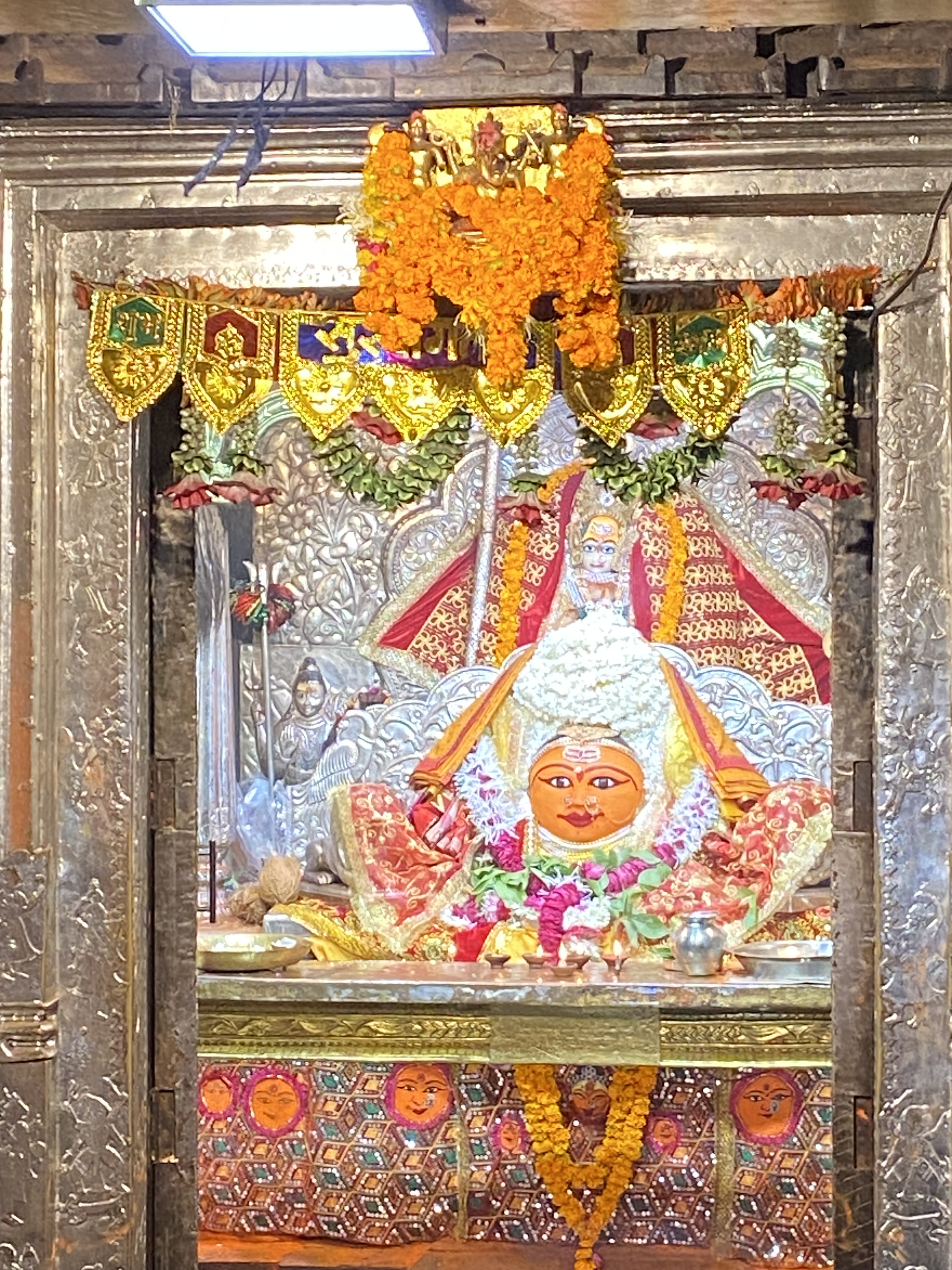
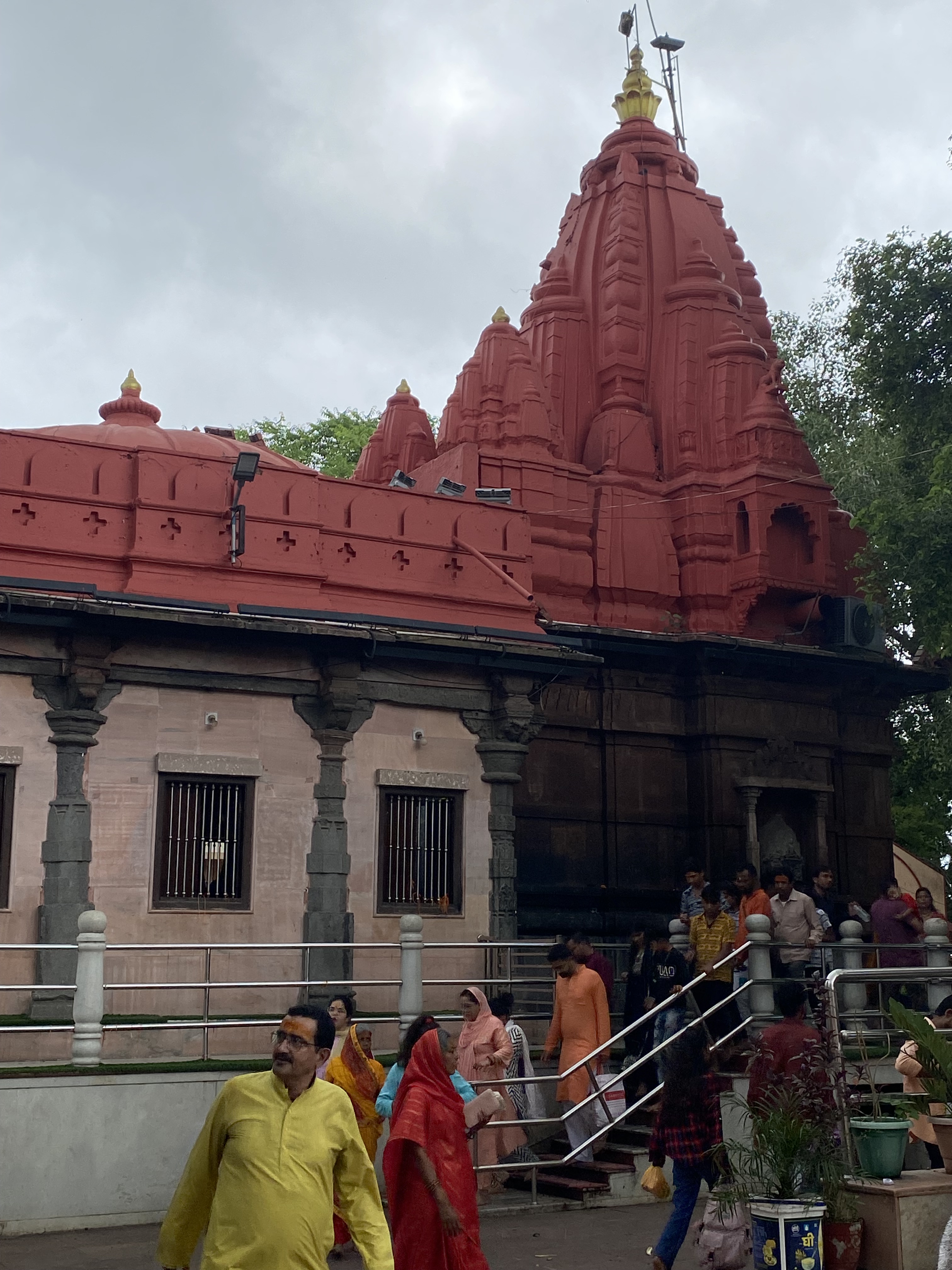
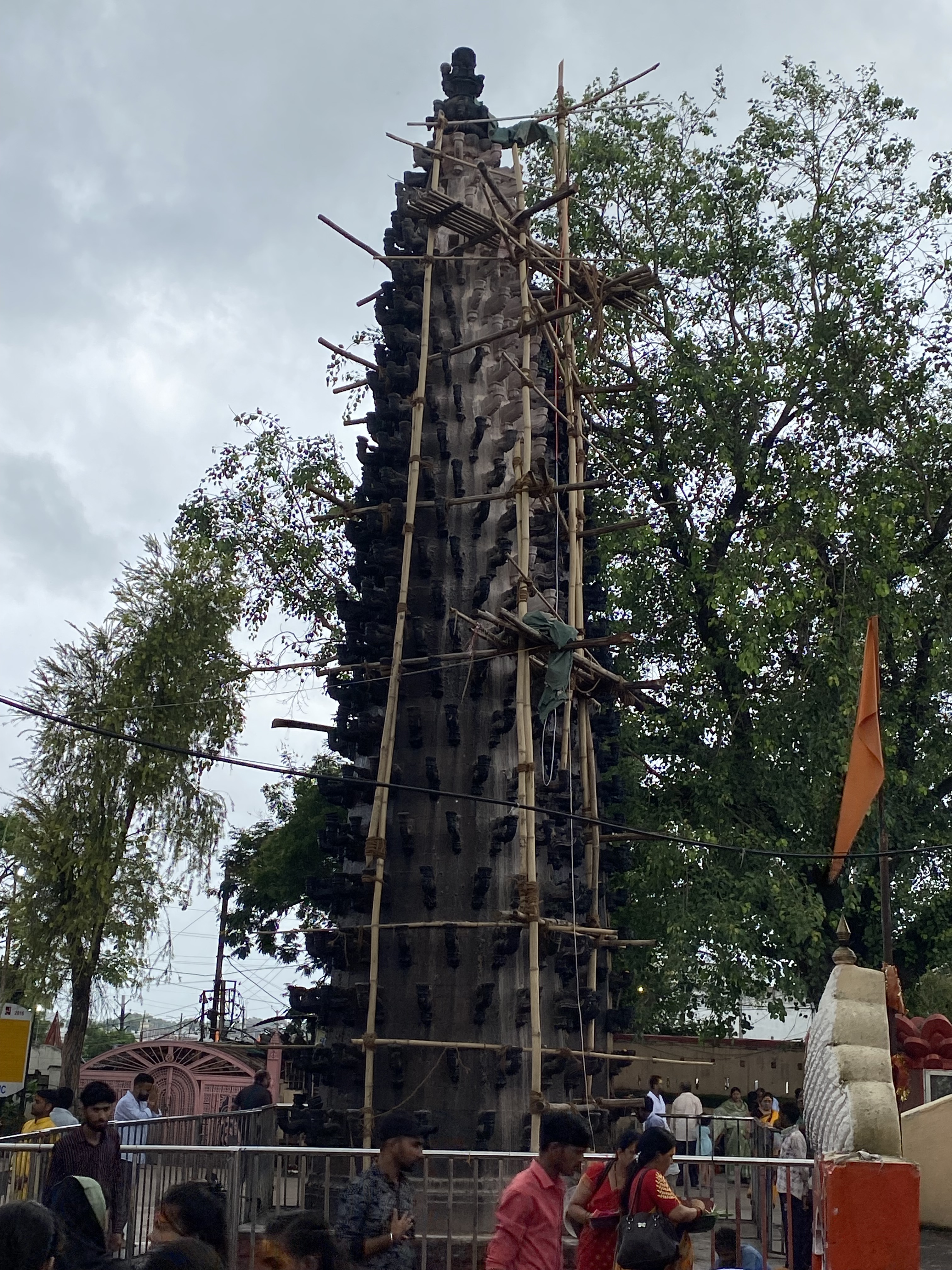
Lunch was at Shree Guru Sandipani Restaurant adjoining the Sandipani Ashram. Simple, but wholesome vegetarian thali with unlimited portions of every item. Nice fluffy rotis, laddu with coconut, apart from the usual dal, vegetable plus the local dish – Dal Bafla. If you are looking for air-conditioned comfort and liveried waiters, diffused lighting, ambience, et al, forget this place. Enjoyed the homely meal and was rearing to visit the Sandipani Ashram.
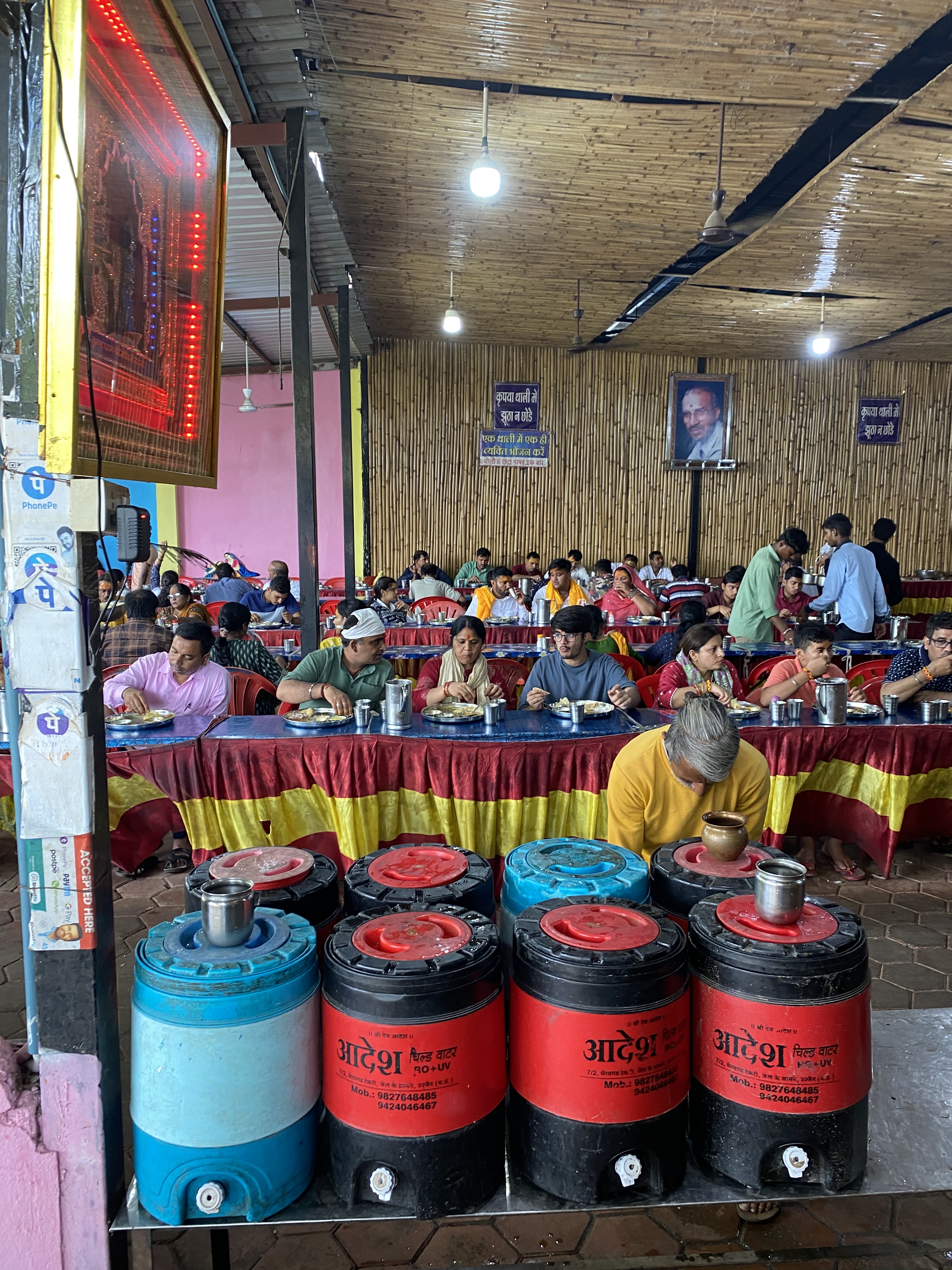
Now we were at the Rishi Sandipani Ashram, the place where Krishna, Balarama & Sudama are said to have learnt the arts and sciences under him. It is a cool shaded place and in the main hall, the walls are adorned with paintings and narrations about Krishna’s life here. It could well take over an hour for those interested to read and appreciate the paintings. What are the interesting aspects of this Ashram that need to be seen? One, the Kundeshwar Mahadev temple dedicated to Lord Shiva. Here we see a standing Nandi, very rarely seen. The priest explained that there was an occasion when the Lord Himself got up, all the devas got up and Nandi had no choice but to stand up. The second is the Sarveshwar Mahadev temple, where the lingam is said to be 6000 years old. Here, a charge of Rs.50 is collected for visitors to perform milk abhishek, a small cup of milk being provided by the temple. The third place is Gomti Kund, a small pond with steps, that Krishna is said to have filled with water from various holy rivers/lakes/springs for the benefit of Guru Sandipani.
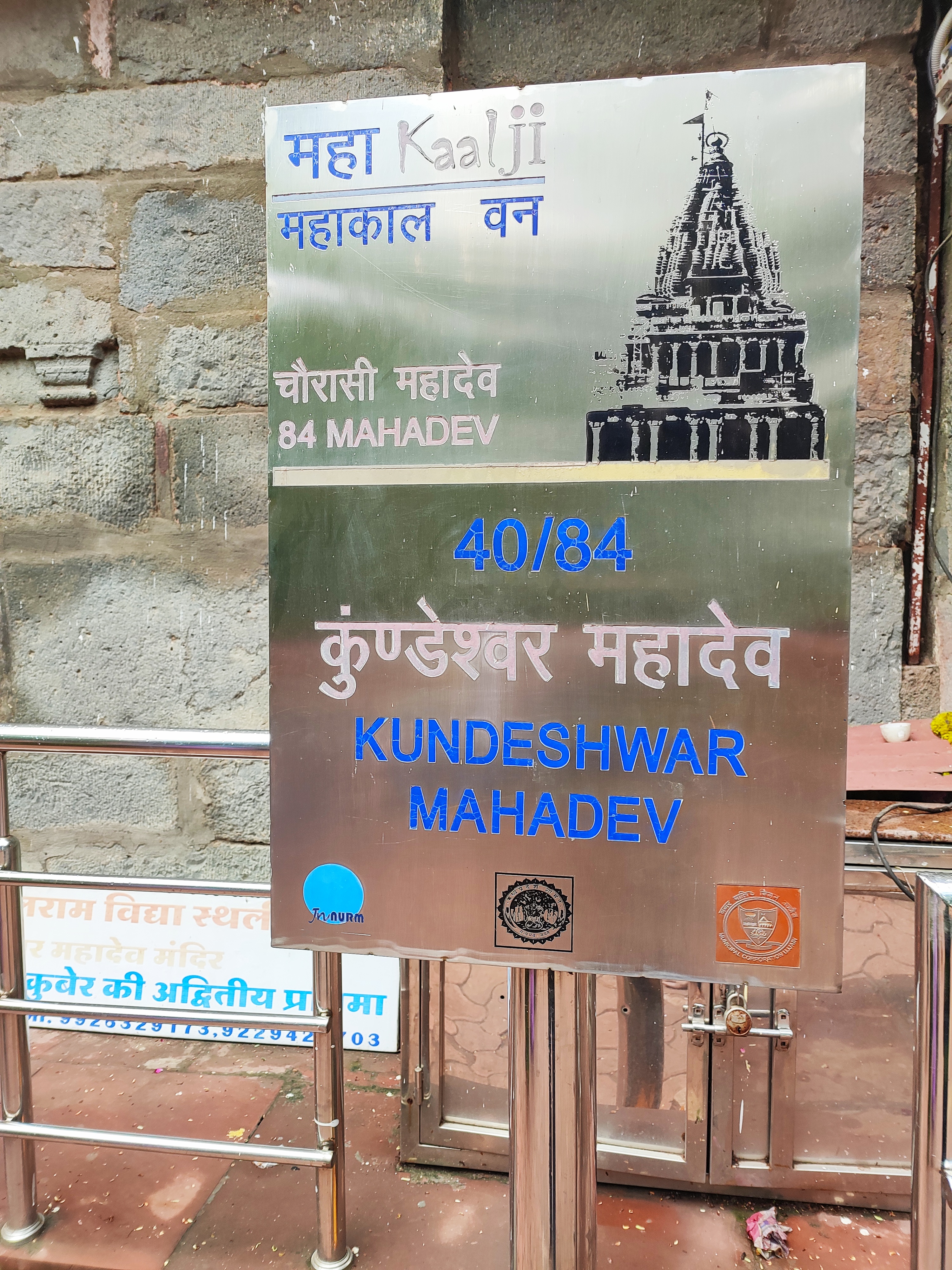
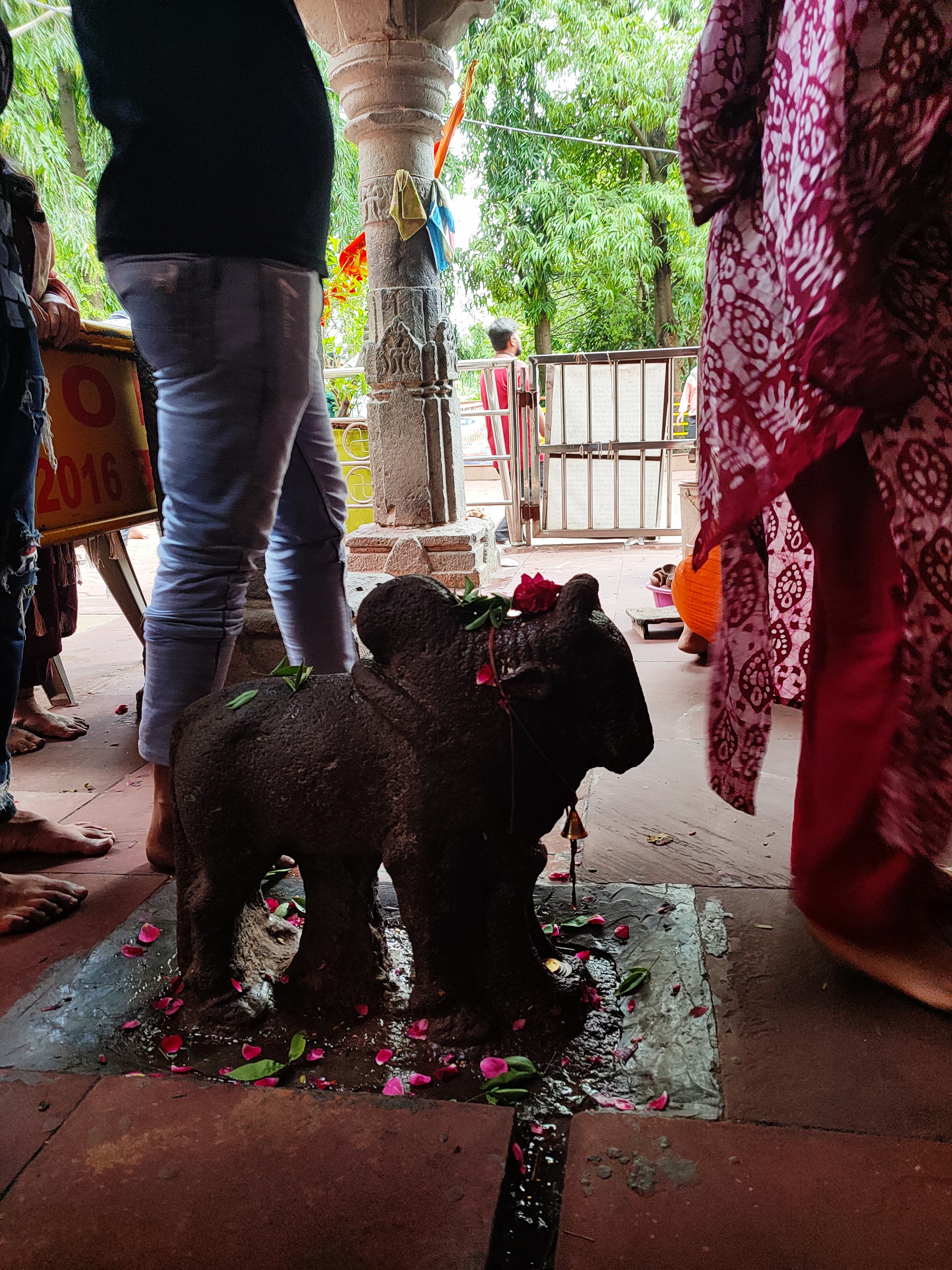
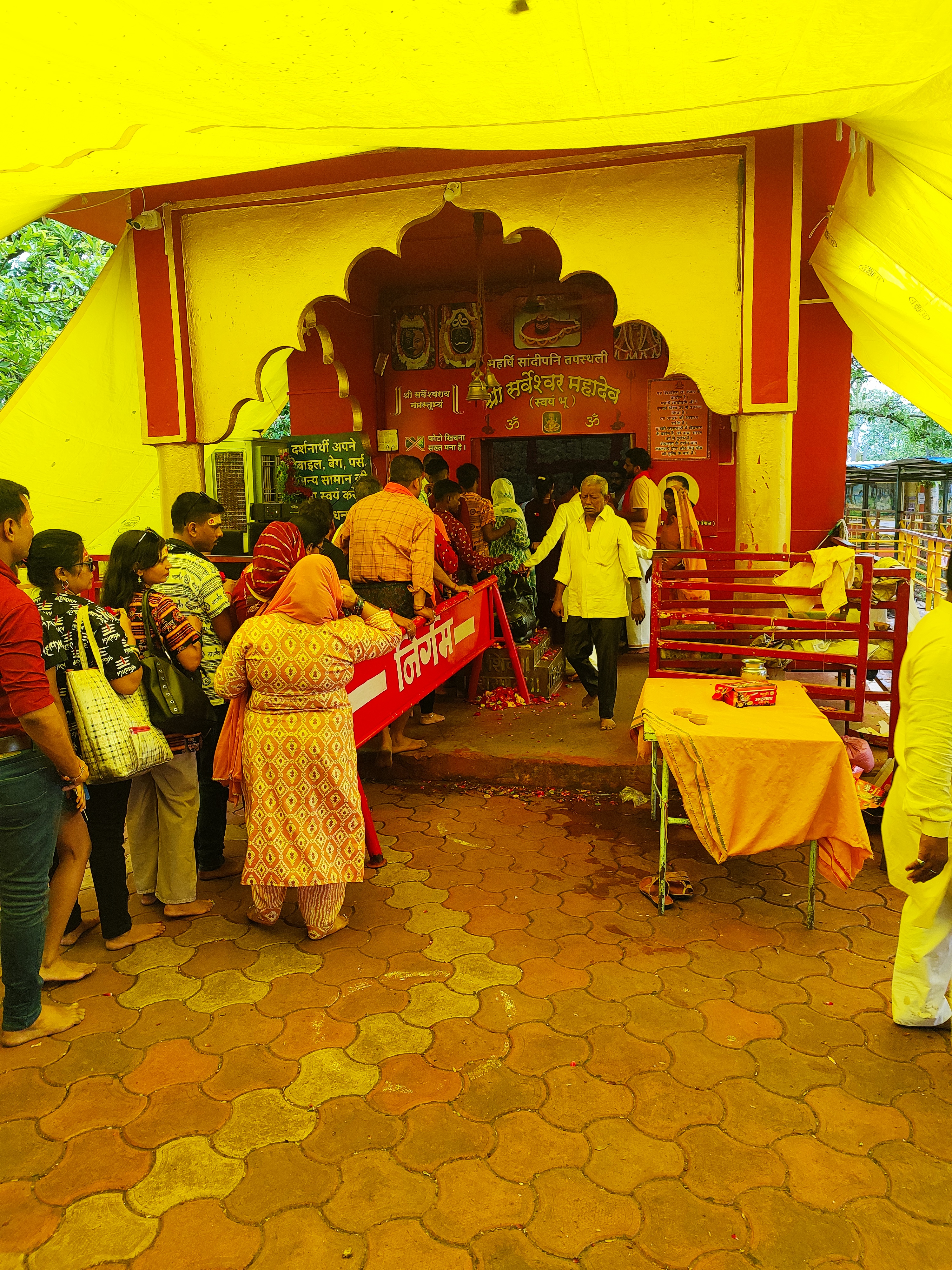
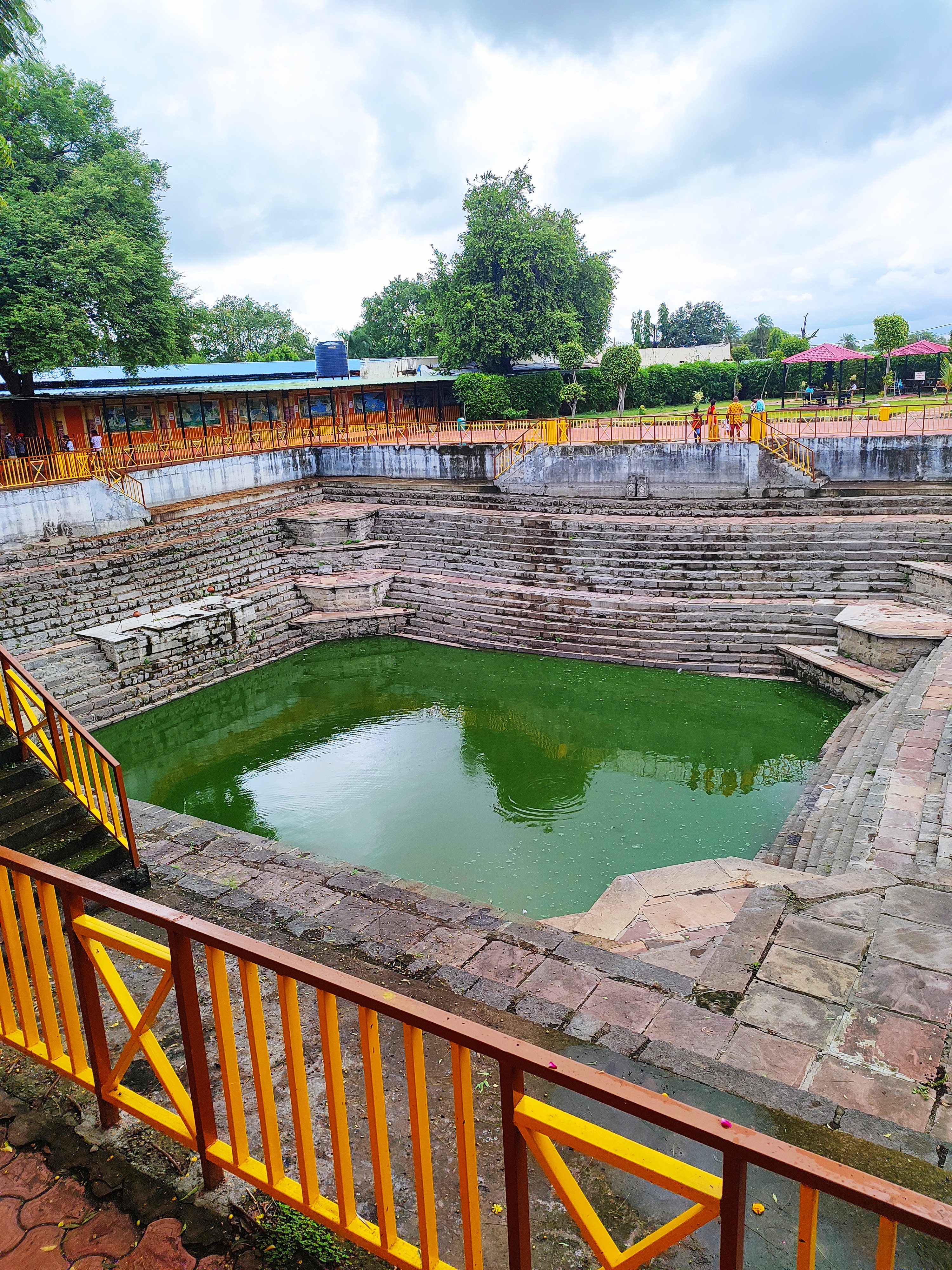
It was around 3.30 PM and our driver was confident that we could cover all the intended spots before retiring for the day. A short drive to a less crowded portion of the city and we were at the Mangalnath mandir, a temple dedicated to Mangal or Mars, who is said to have been born here. The temple is on a small hillock, the highest point in Ujjain and overlooking the Shipra river, that was algae-laden here. Surprisingly, there was a queue and we could see many with ‘Mangal dosha’ performing various poojas in the hall aided by pandits, obviously for a fee. Darshan of Mangalnath done, we stepped out into the courtyard to catch the cool breeze and the great view.
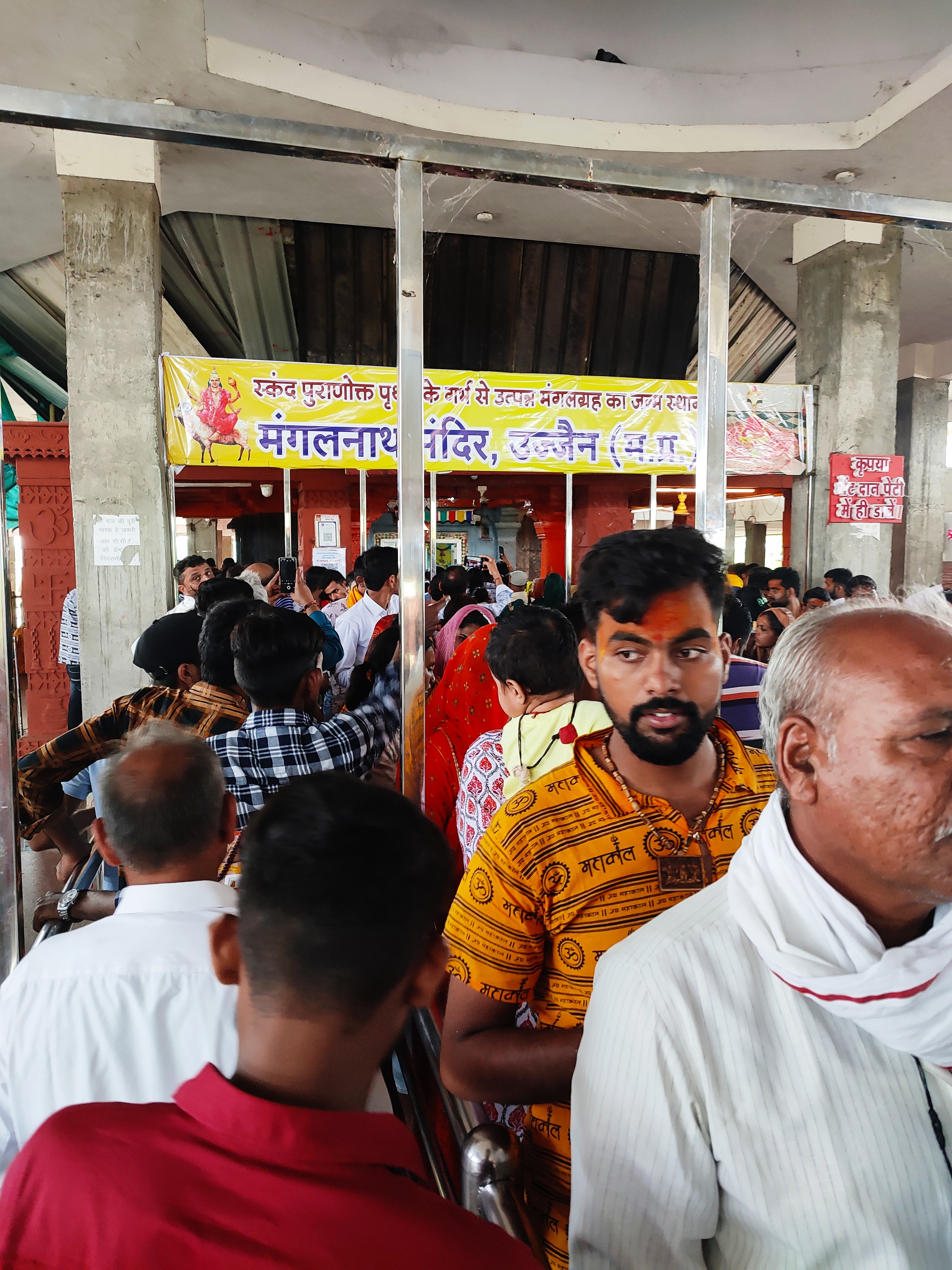
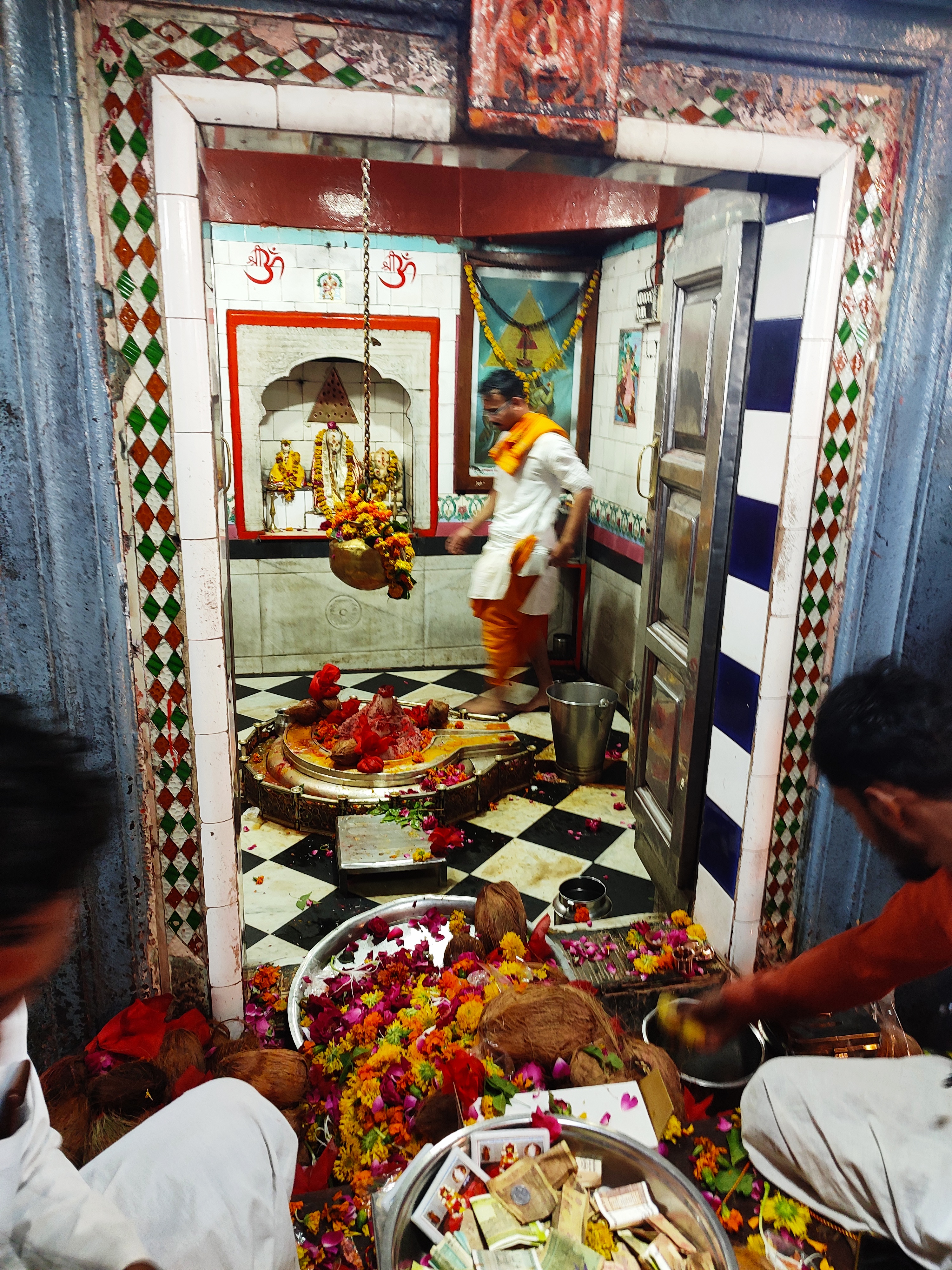
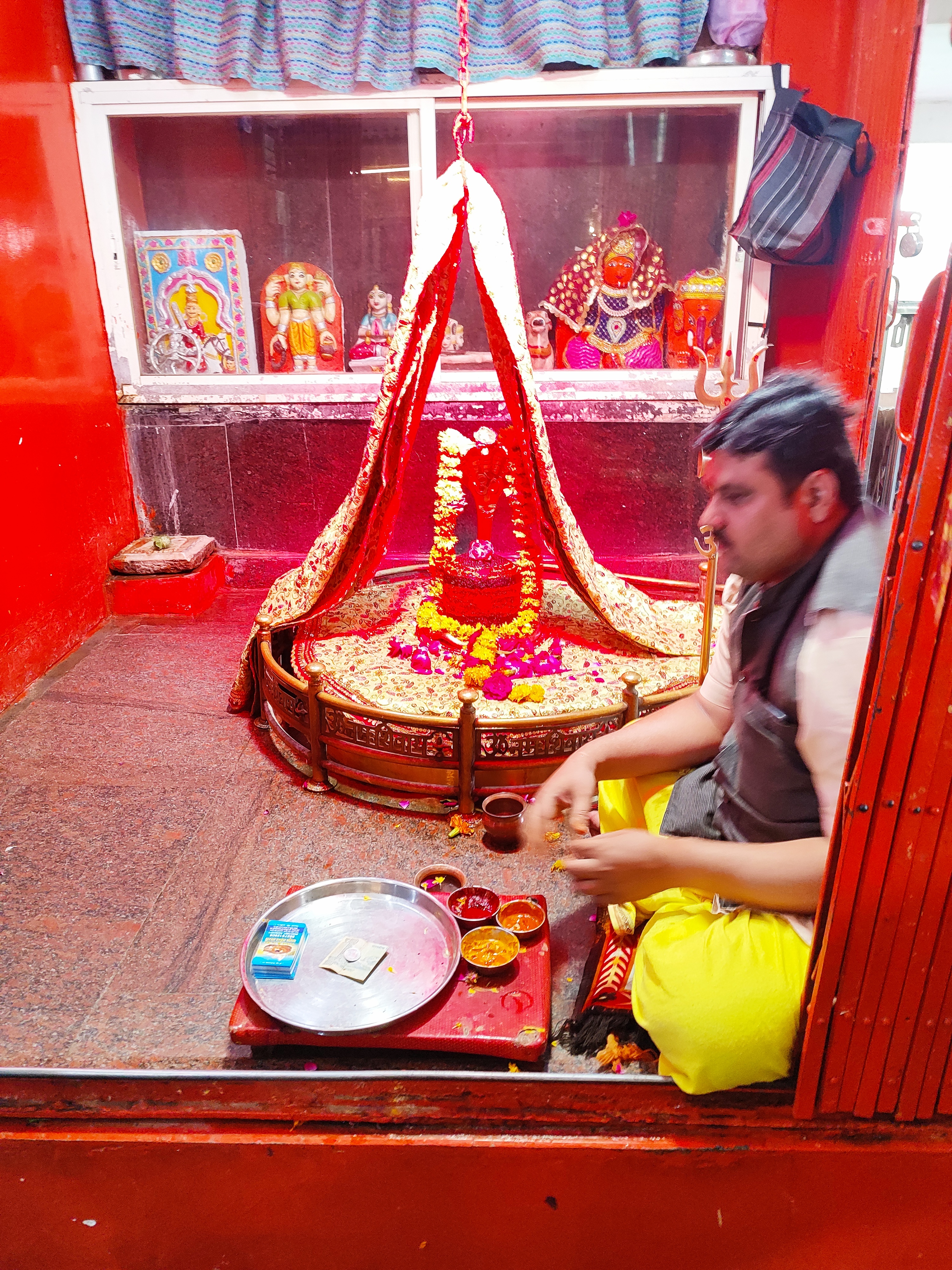
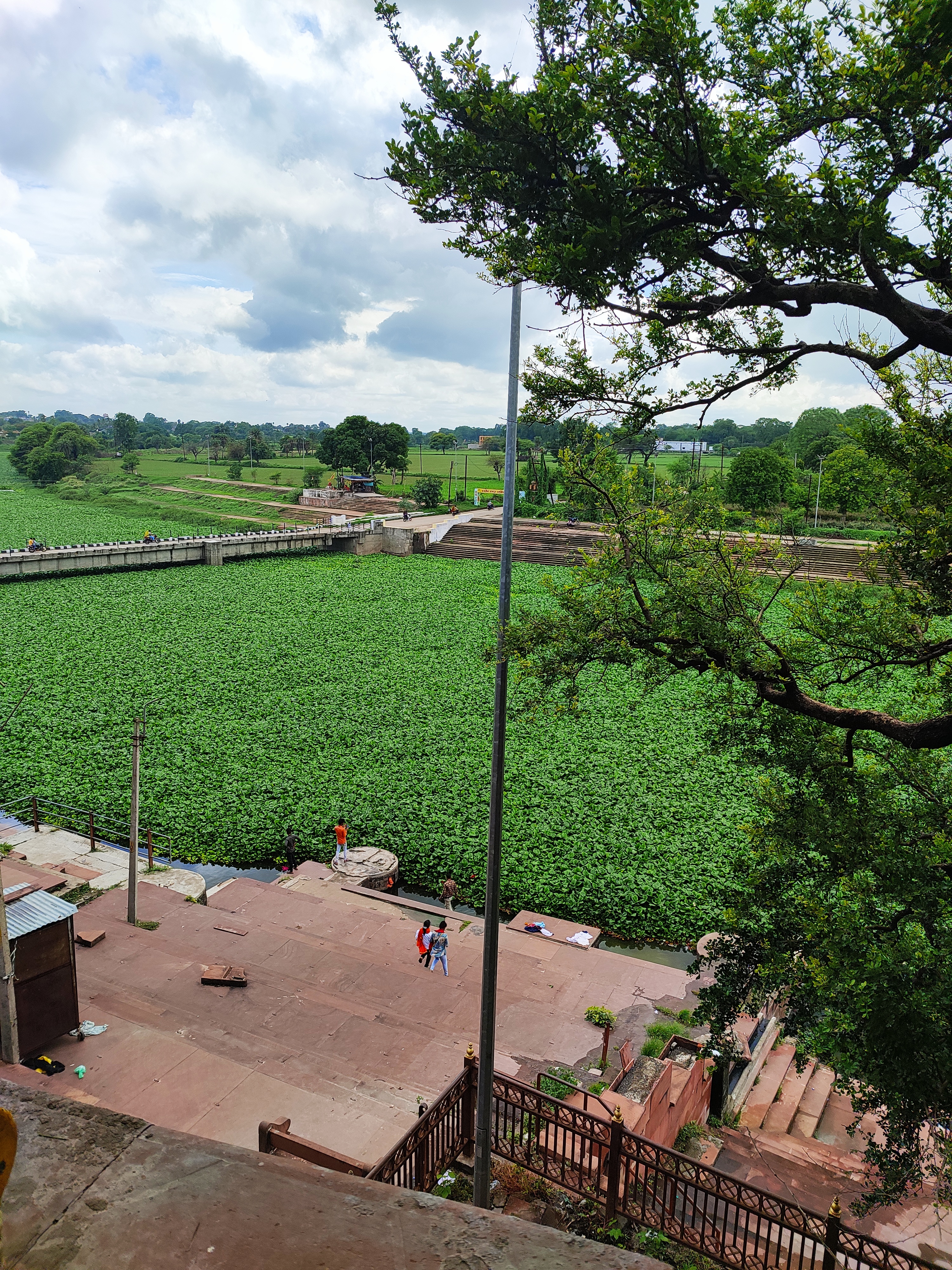
The weather had turned a little cloudy and there was a threat of rain, when we drove to the Kal Bhairav Mandir. Having parked the car in an open parking lot, we walked across a mud road lined with shops selling materials for the pooja. Among other things in the pooja basket was a small bottle of liquor. Yes, liquor is one of the offerings made to Kal Bhairav and it is believed that in the evening pooja, the priest opens a bottle of liquor and pours a portion of it in the lips of the Kal Bhairav murti and the liquor actually disappears. The original temple is said to be built by King Bhadrasen and the current structure by the Maratha rulers. We joined the queue in the open that moved at a snail’s pace. Add to it the partly slushy ground, our bare feet and swarming flies, I was pretty irritated. The parting barricades were covered with threads/beads that were offerings by devotees. After an hour, we could make it before Kal Bhairav, the guardian deity of Ujjain and had a nice darshan. The effort and wait seemed to be worth it.
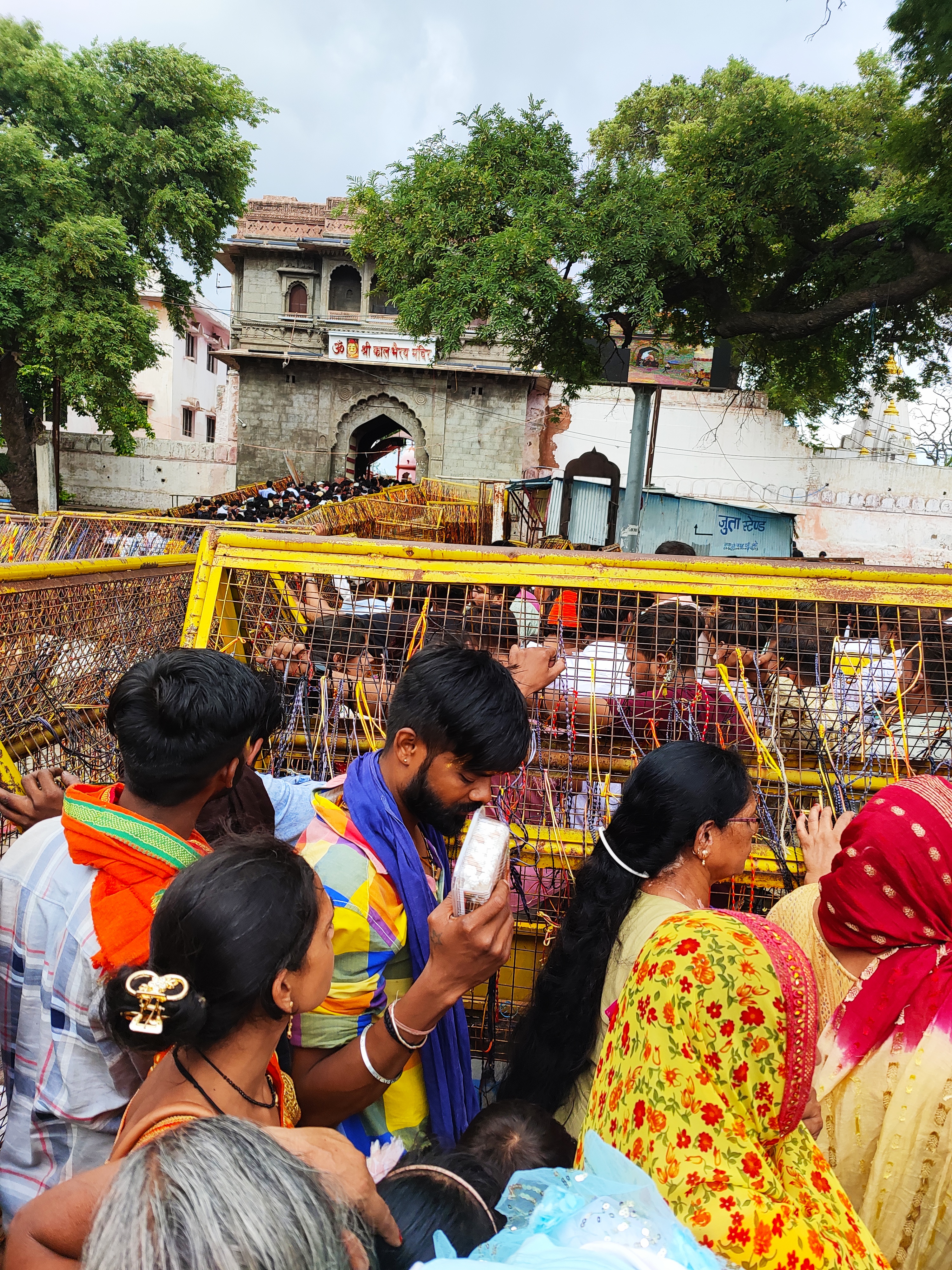
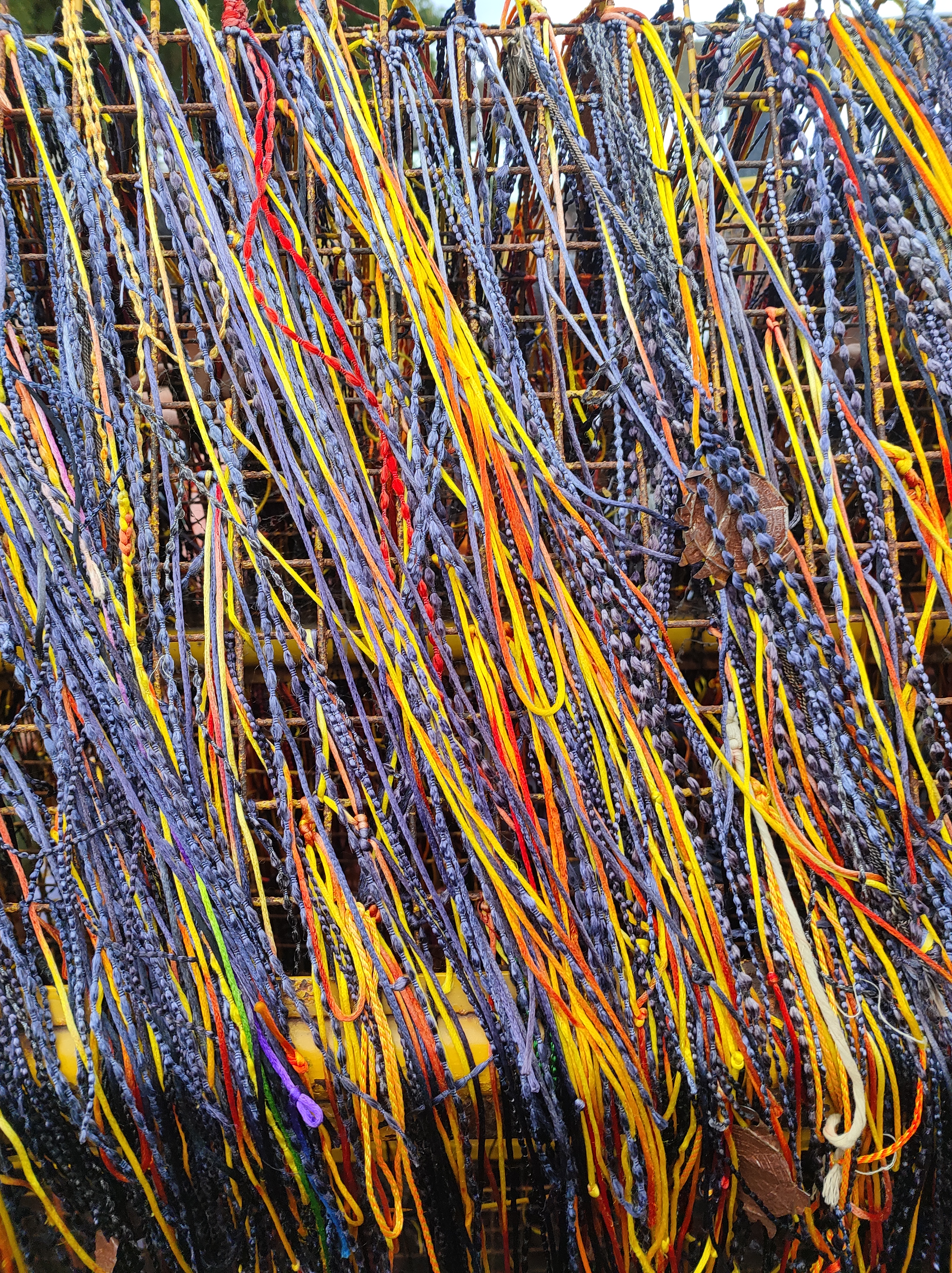
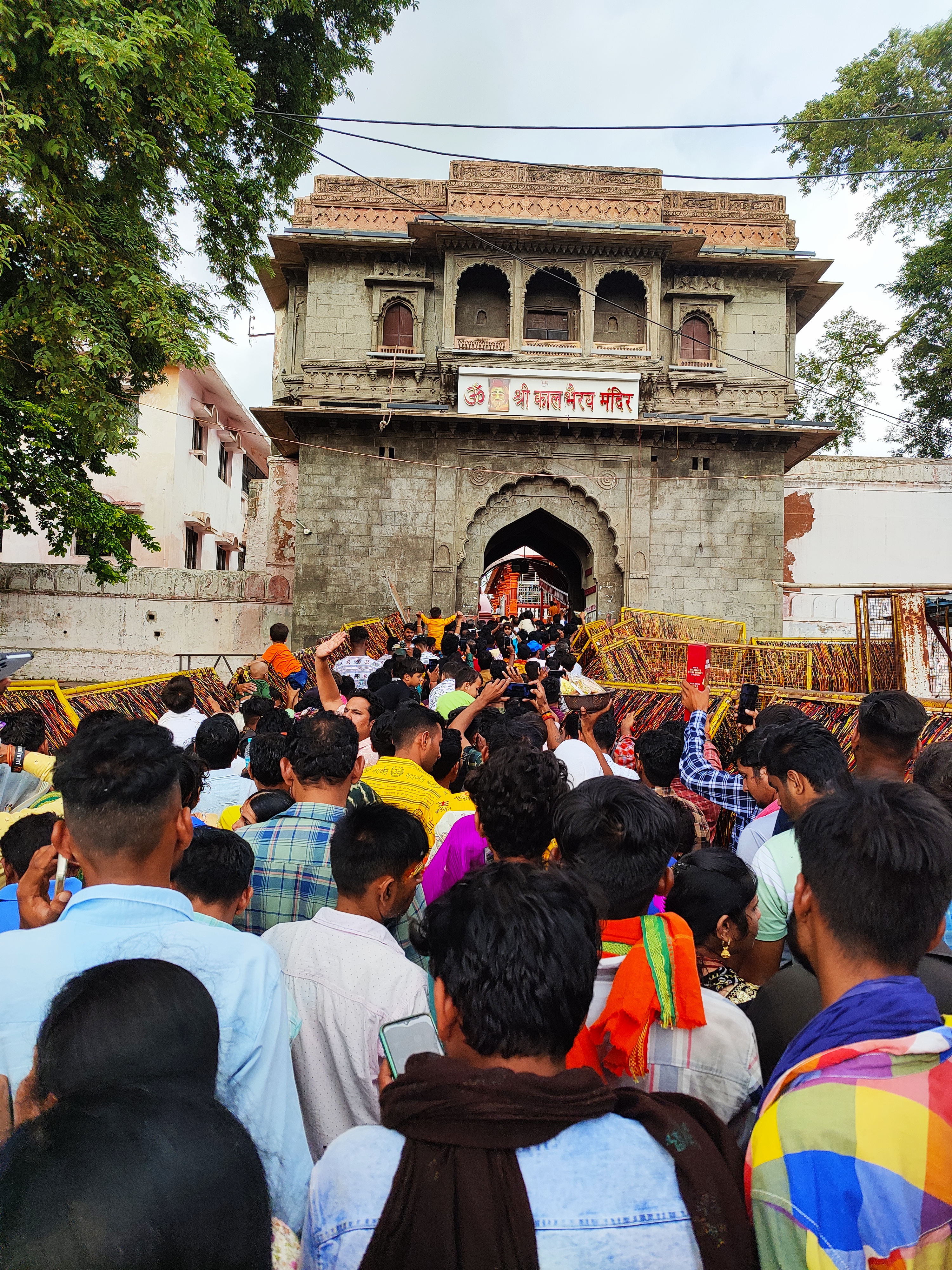
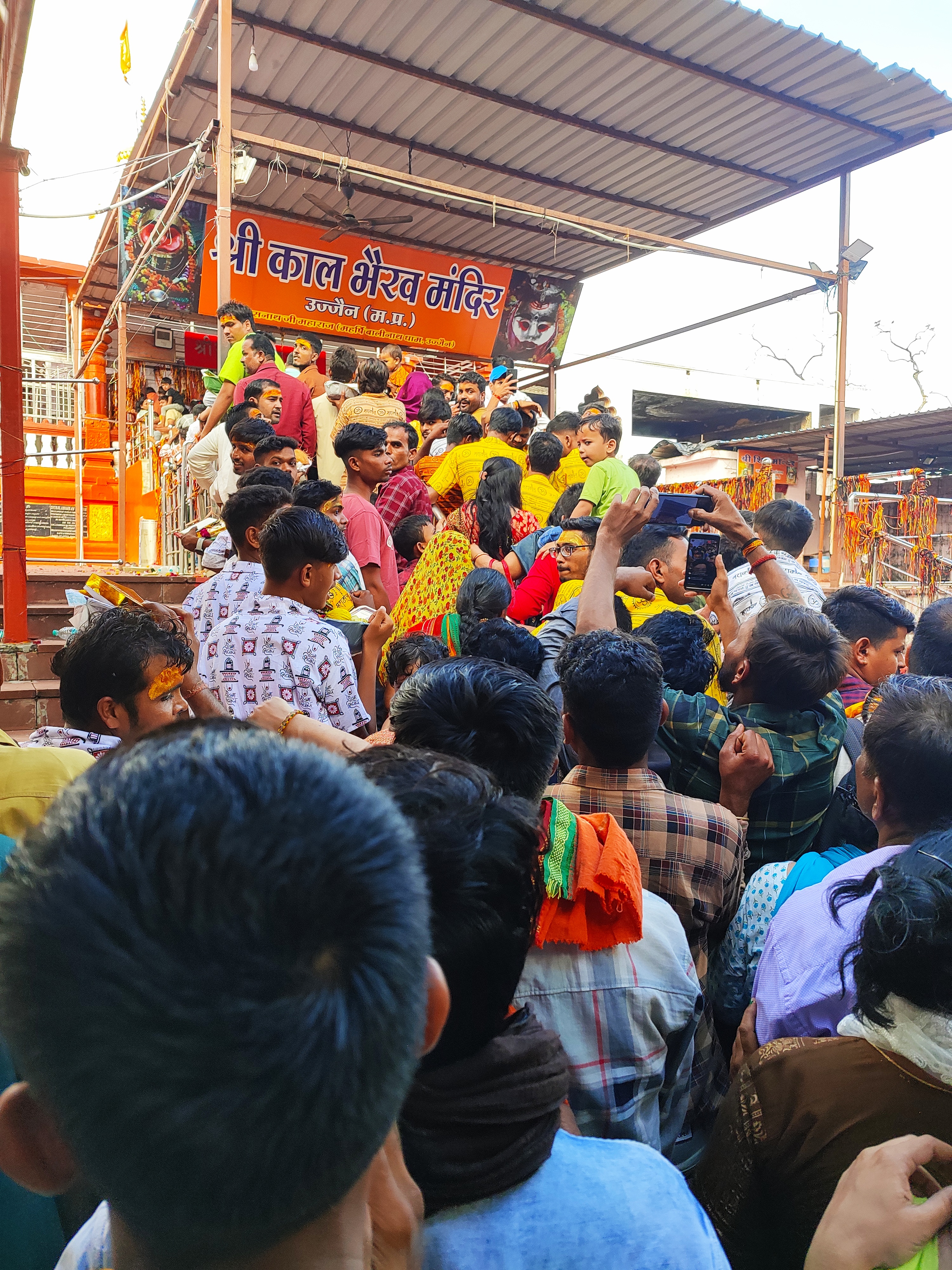

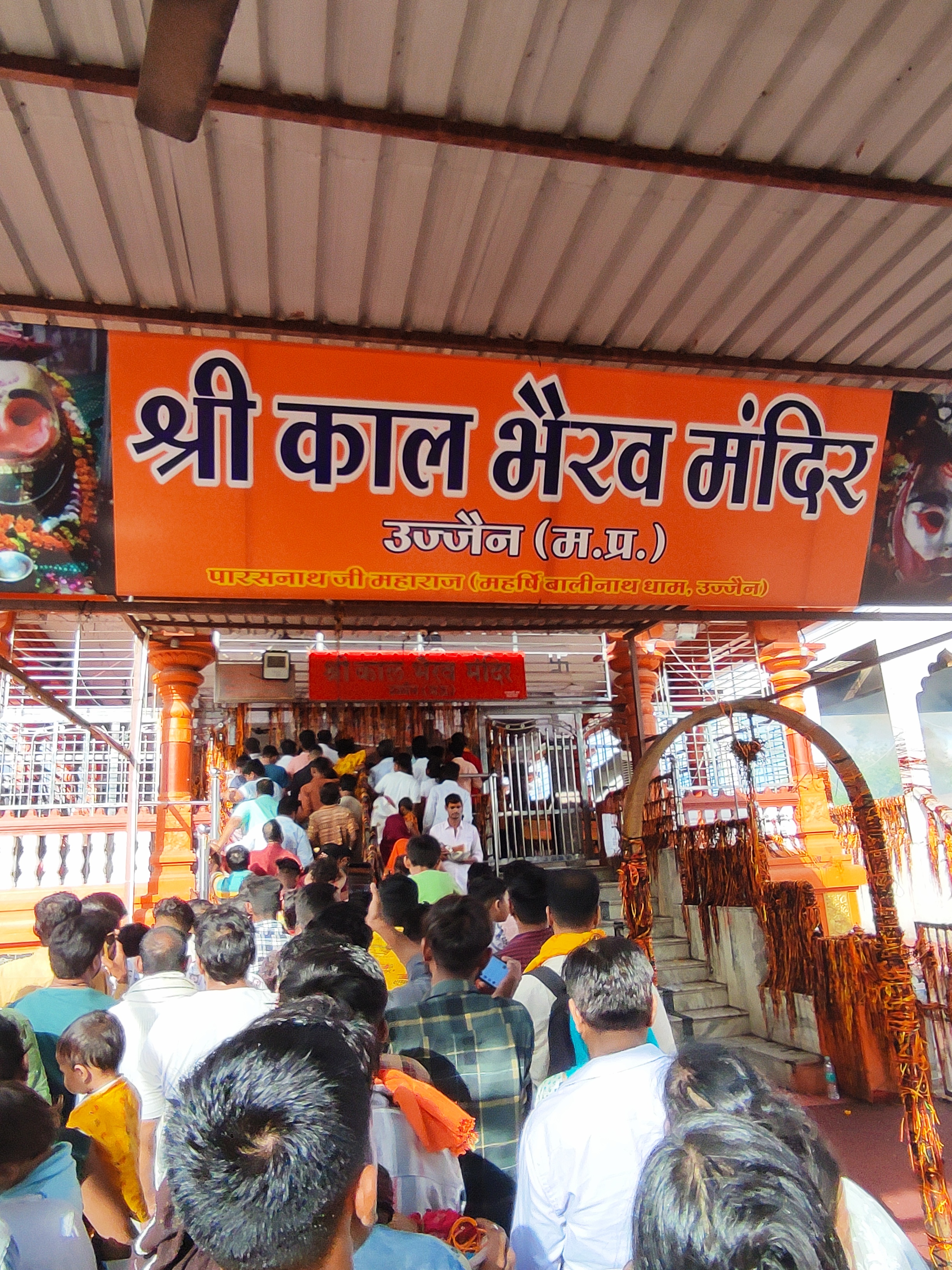
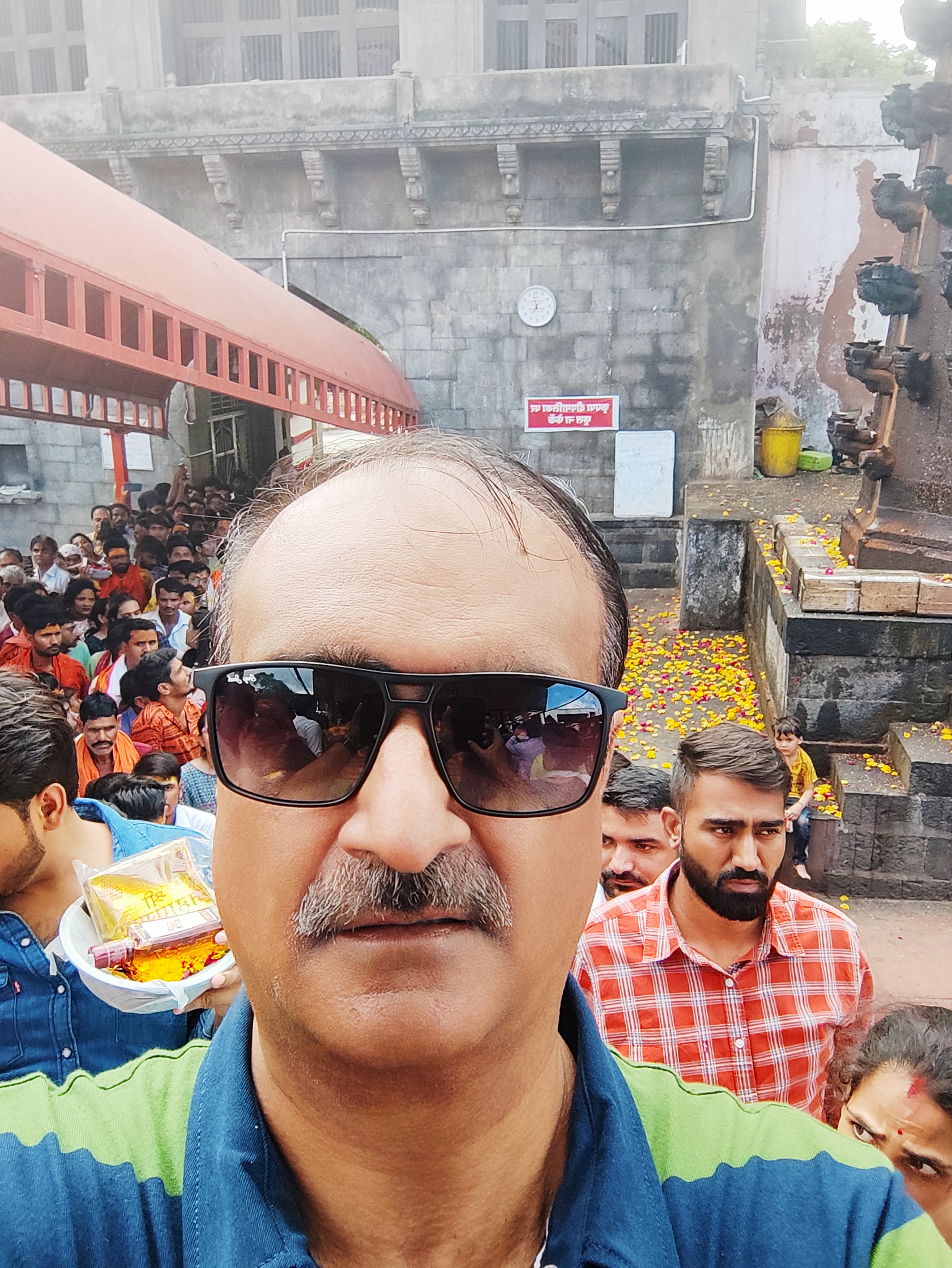
We now drove down to a small temple, the Temple of Gadkalika. It is a quaint temple, not crowded for Shaktipeeth. Gaily painted and we could see an assembly of musicians getting ready for the evening aarti. We had a quick darshan before moving ahead. The importance of this temple — It is said that Kalidasa prayed to the Kali here and from an uneducated youth, he got transformed to a legendary poet. The idol is said to be very old, dating back to even before the Mahabharata war. It is also said that when Shiva was carrying the burning body of Sati, her upper lip fell here.

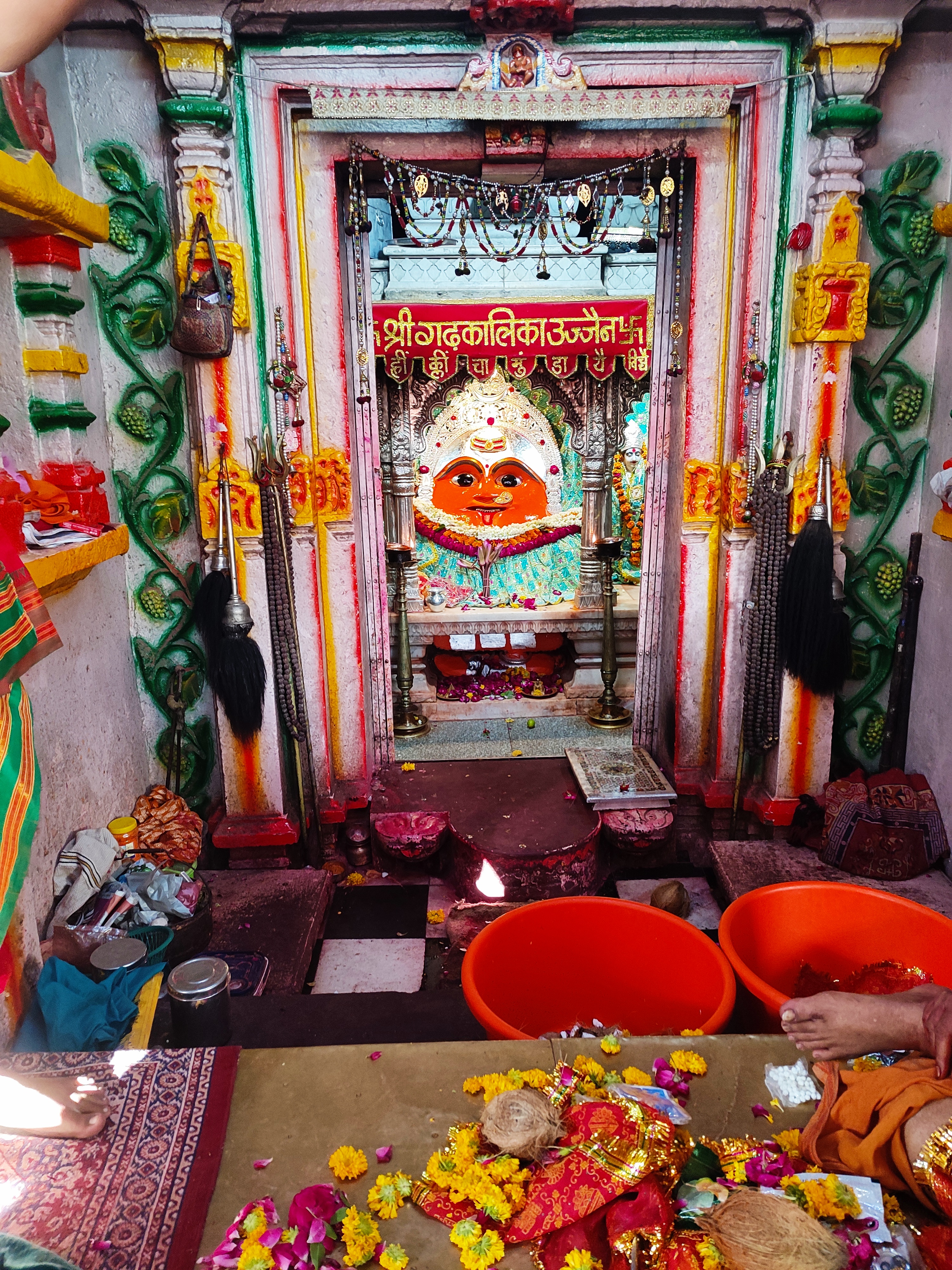
At a short distance from Gadkalika, at a slight elevation are the Bhartrihari Caves. These are the underground caves where Bhartrihari, stepbrother of King Vikramaditya is said to have been in penance as an ascetic. He was a king, who became an ascetic, disgusted with his wife’s infidelity. Frankly, I did not find the place worthy of a visit. There are boards with the stories of Bhartrihari, idols of gods and of course the underground caves. My wife refused to climb down. I did go inside one of these underground chambers, climbing down steep, narrow steps, only to step into a musty smelling hall with a low ceiling. Slight difficulty in taking in the stale air, but wonder of wonders, I could see a couple of hermits meditating here. I hastily beat a retreat outside to breathe the fresh air. The sight of a gamboling langur in the open courtyard was more interesting to the visitors.
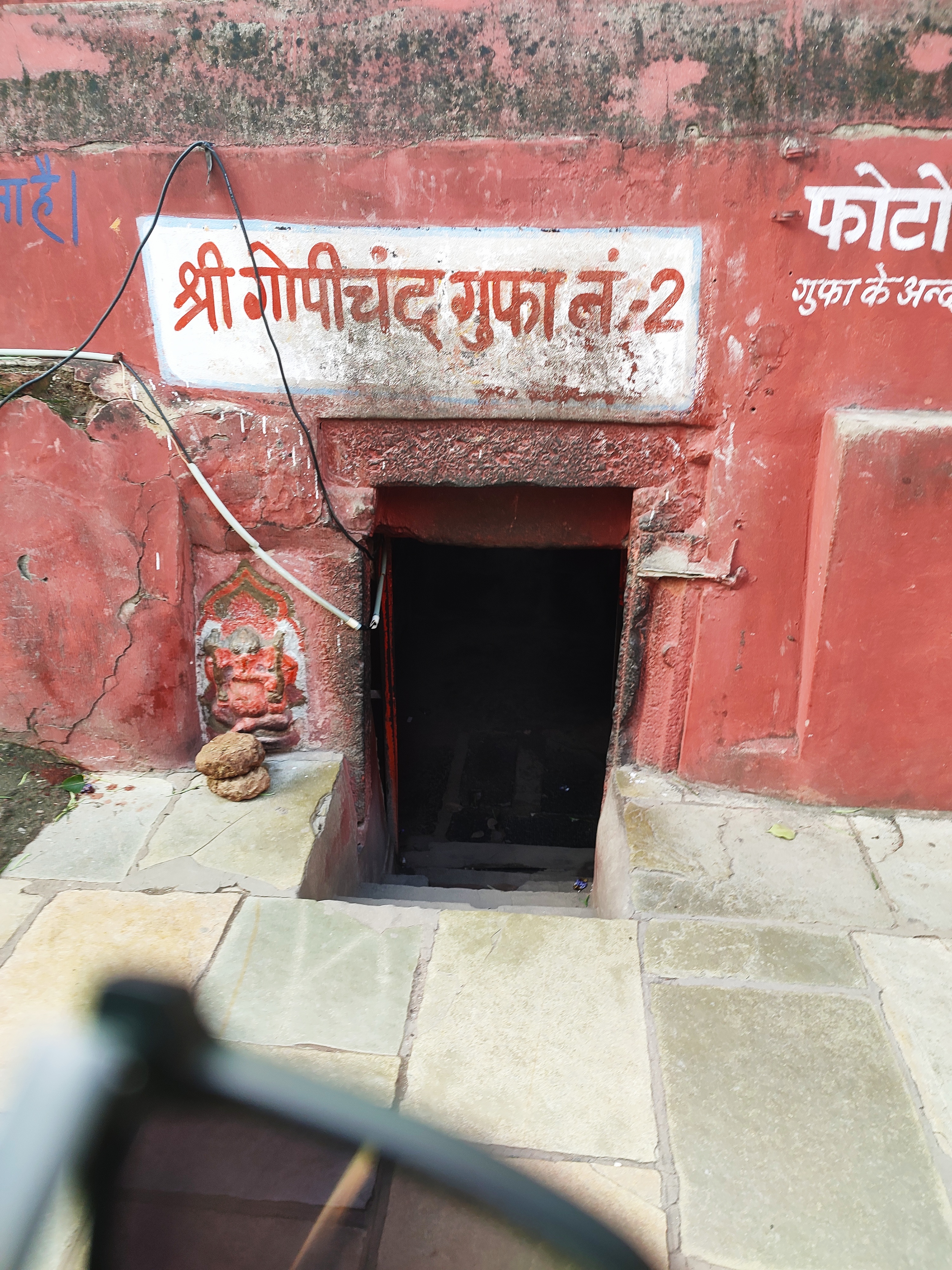
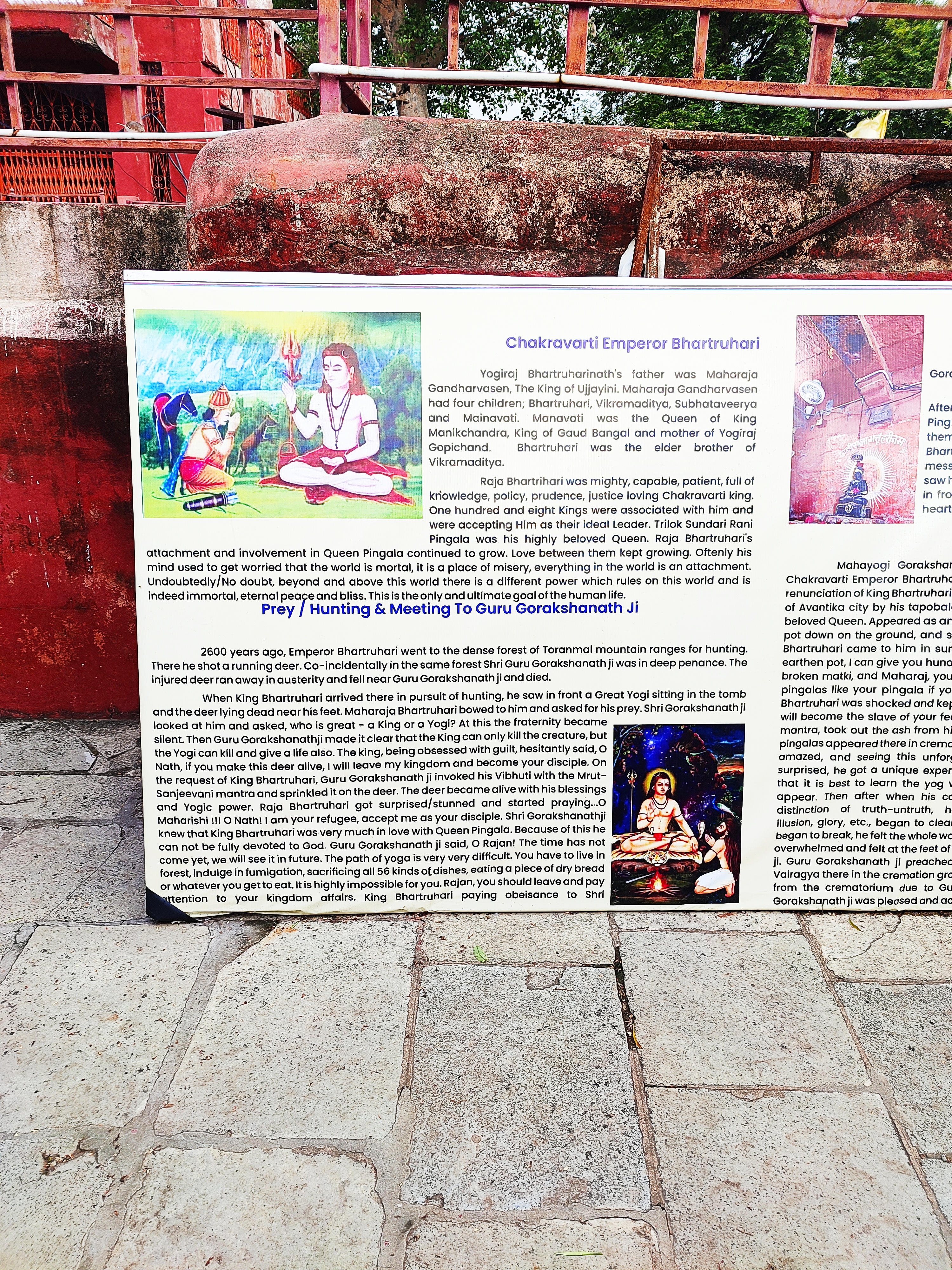
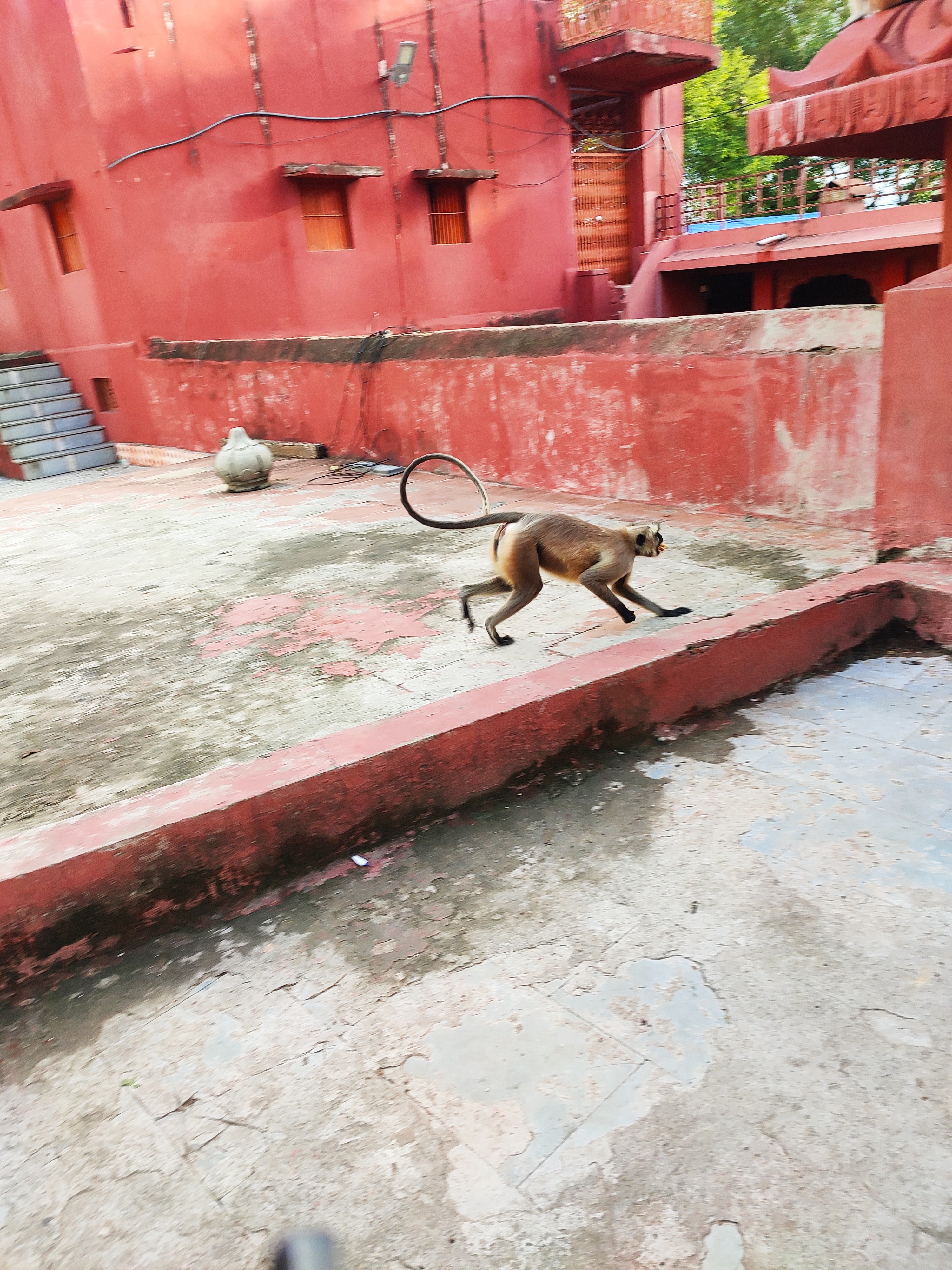
We were now getting late for the Shipra aarti. Soon we reached the ground where the Kumbh Mela is held with the adjoining bathing ghats on the Shipra. We were extremely thirst and surprisingly not a single shop nearby selling cool drinks. It was only roadside vendors hawking ‘nimbu paani’. Walked further up, finally found a cool-drinks stall, our thirst satiated walked back to witness the aarti on the opposite bank. Possibly, the riverfront could be cleaner and made more tourist friendly.

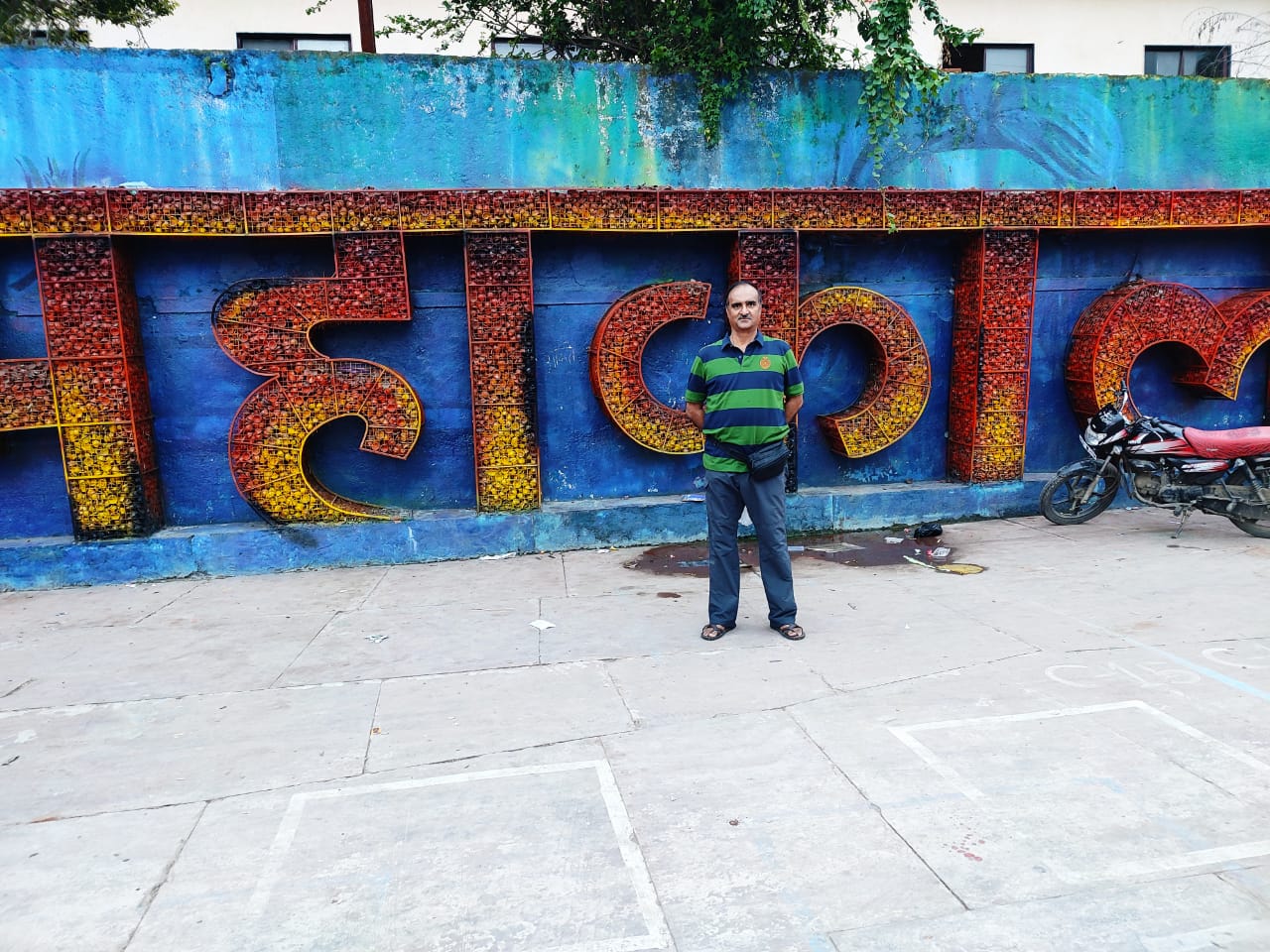
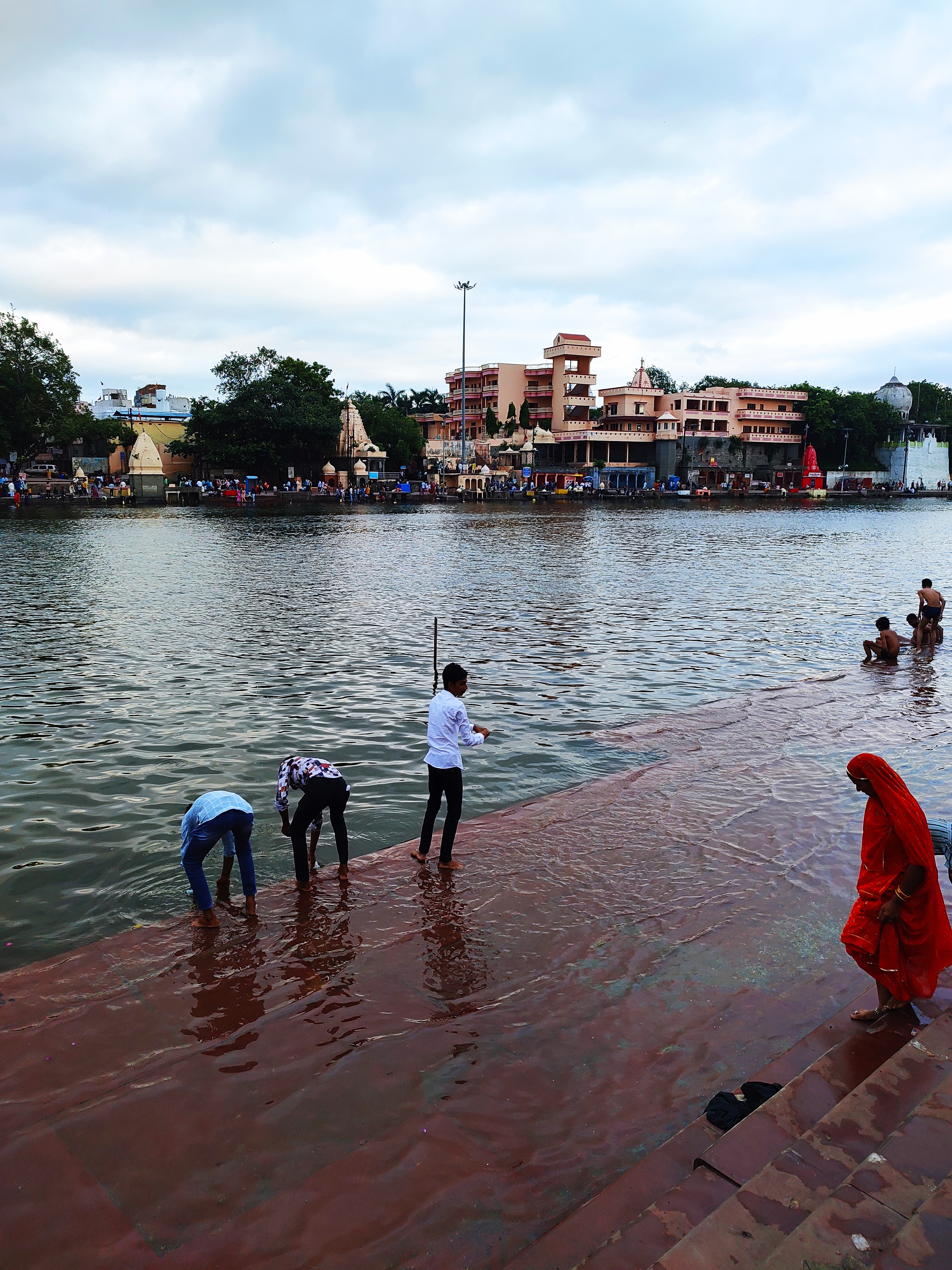
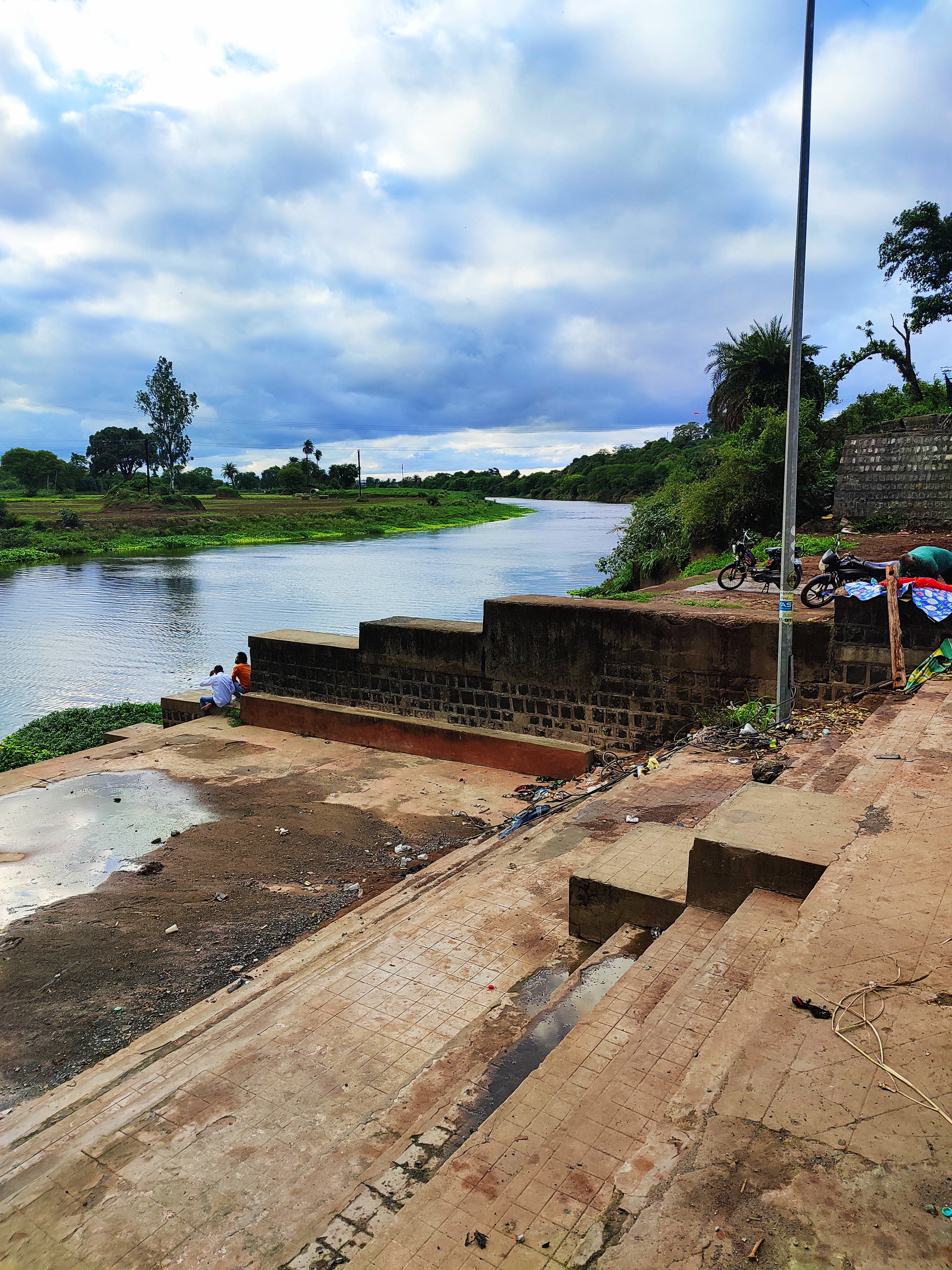
We were yet to see the Mahakal corridor and drove towards it. Alas! There was a traffic problem in the marketplace and we couldn’t reach close to the corridor. Took an instant decision that we would retire to our hotel and visit the corridor first thing in the morning before departing for Omkareshwar, which we successfully accomplished, by 7 AM. The Mahakal corridor is 900 meters long , created recently and some parts still being developed. It has a number of statues depicting scenes from our ancient epics. A neat and clean corridor in which people can walk, relax on the benches with facilities for drinking water & washrooms. It is being developed as a tourist attraction while at the same time re-kindling people’s interest in Hinduism, for all generations.
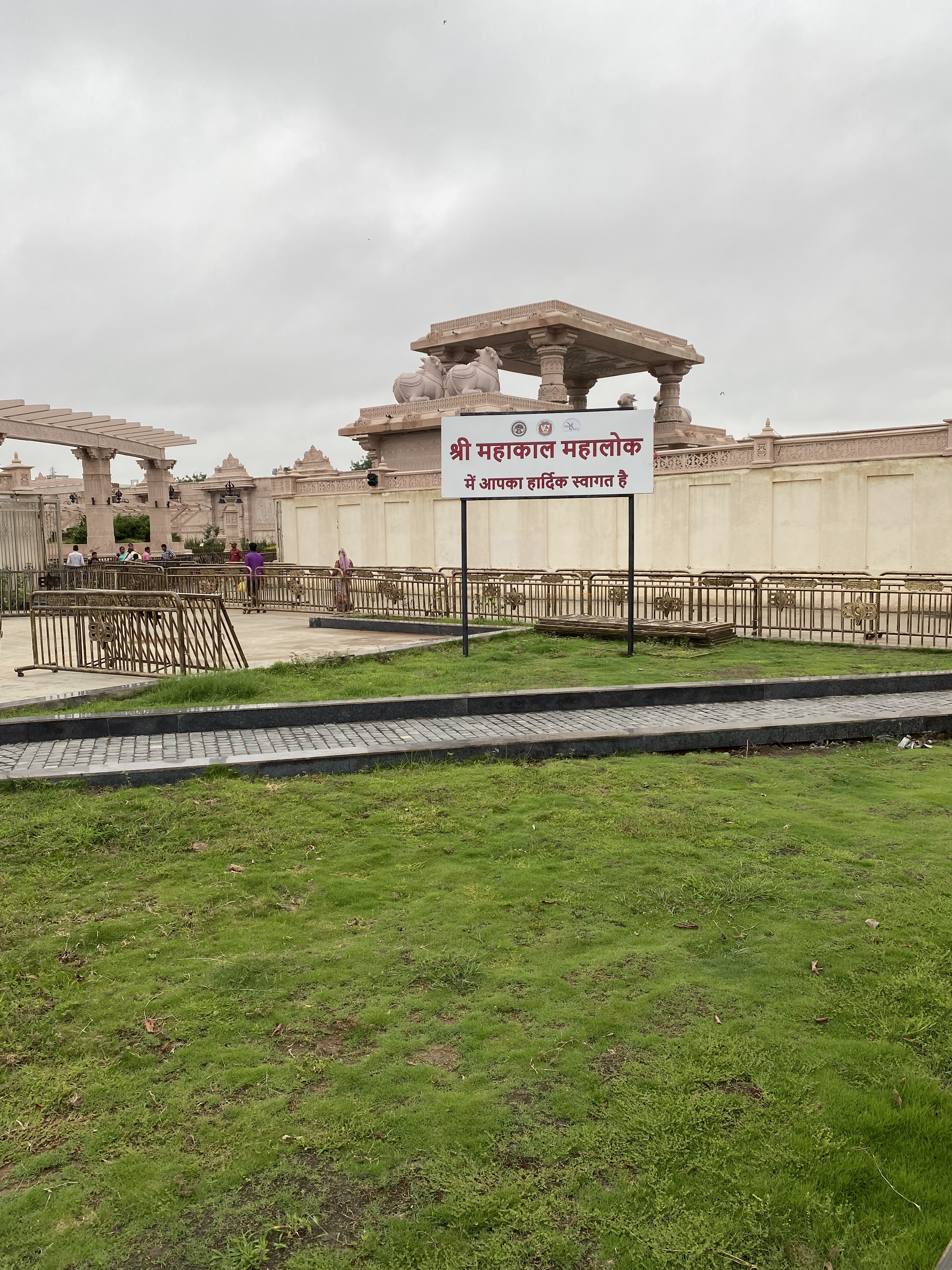
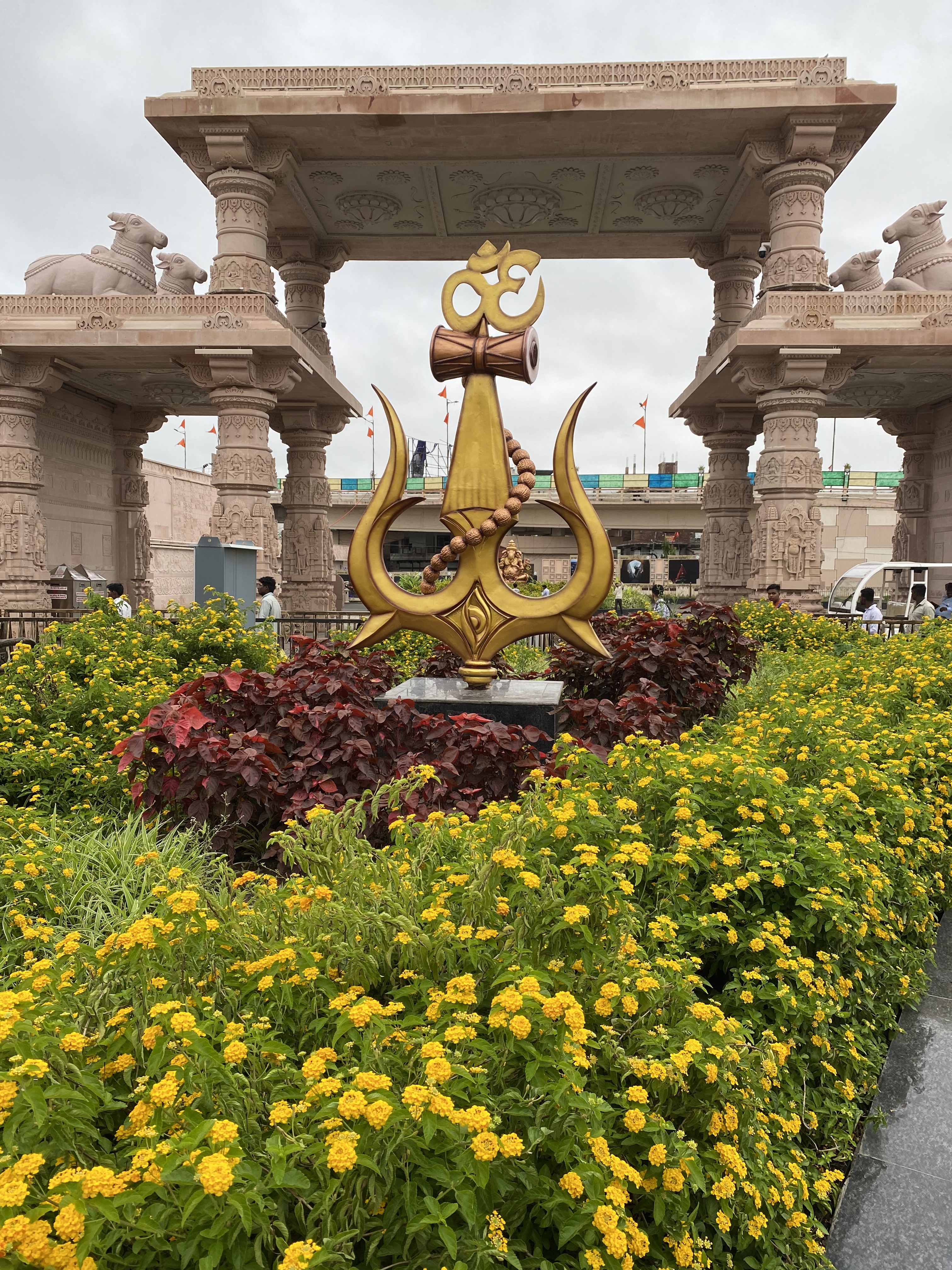
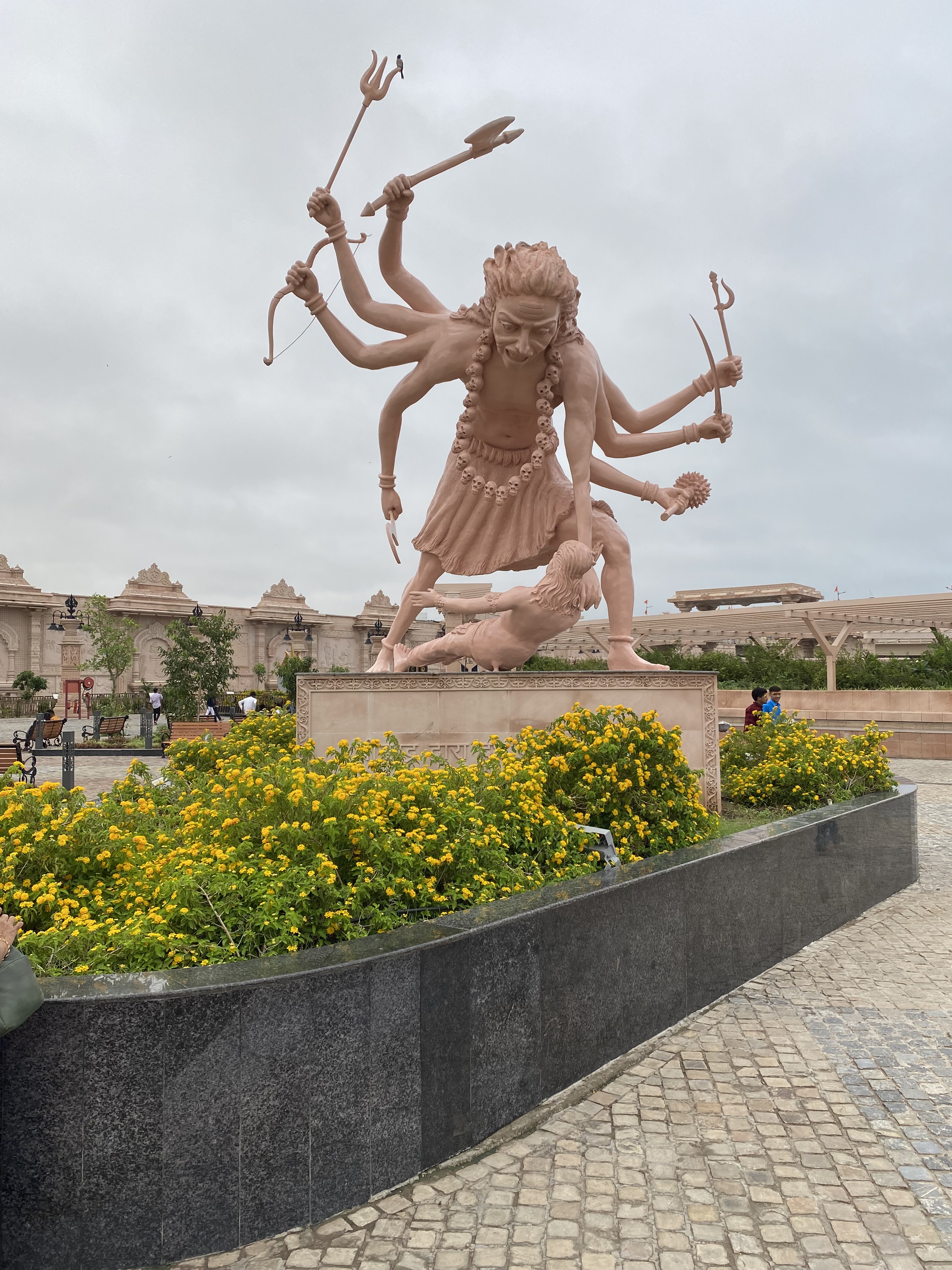
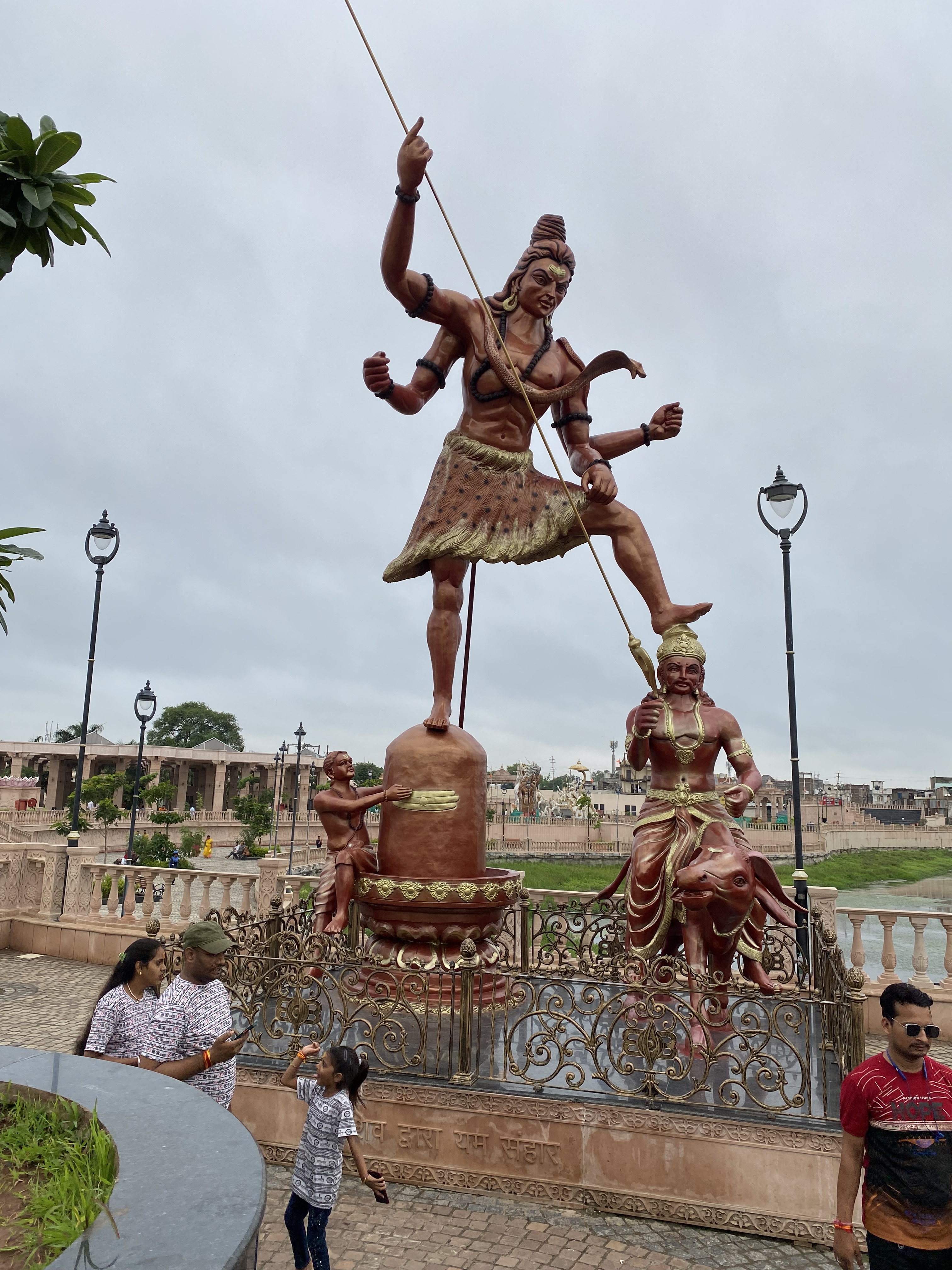
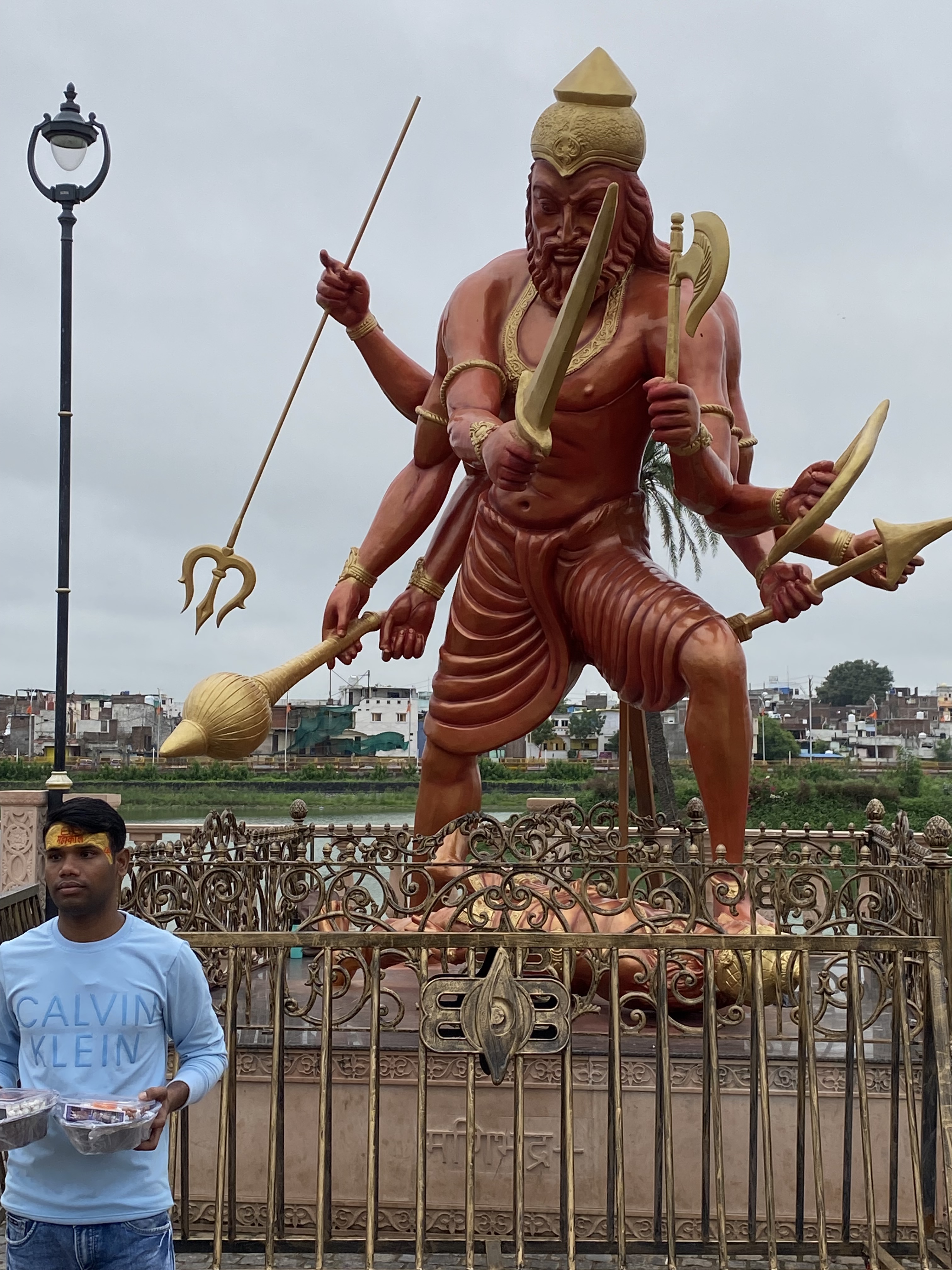
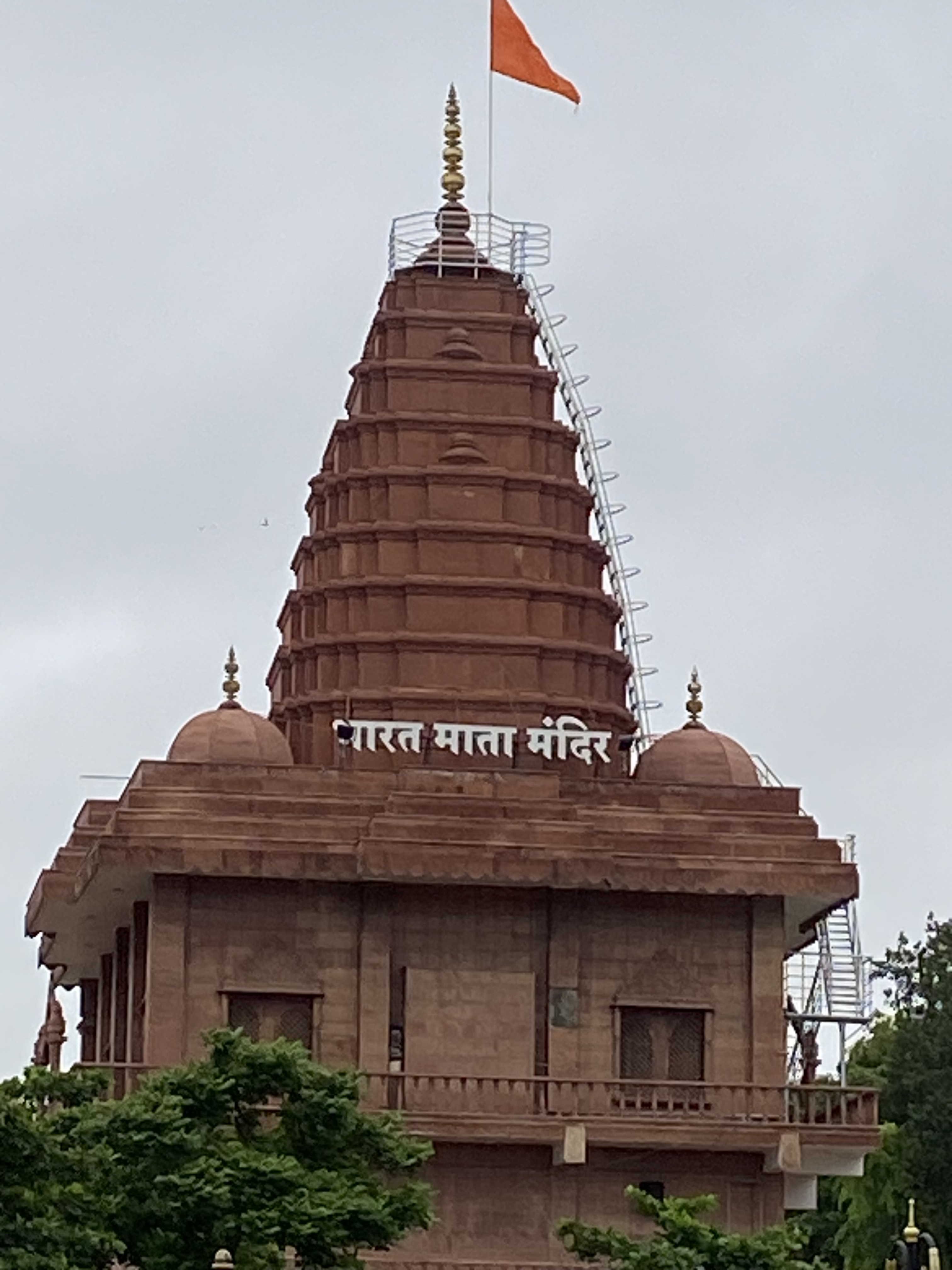
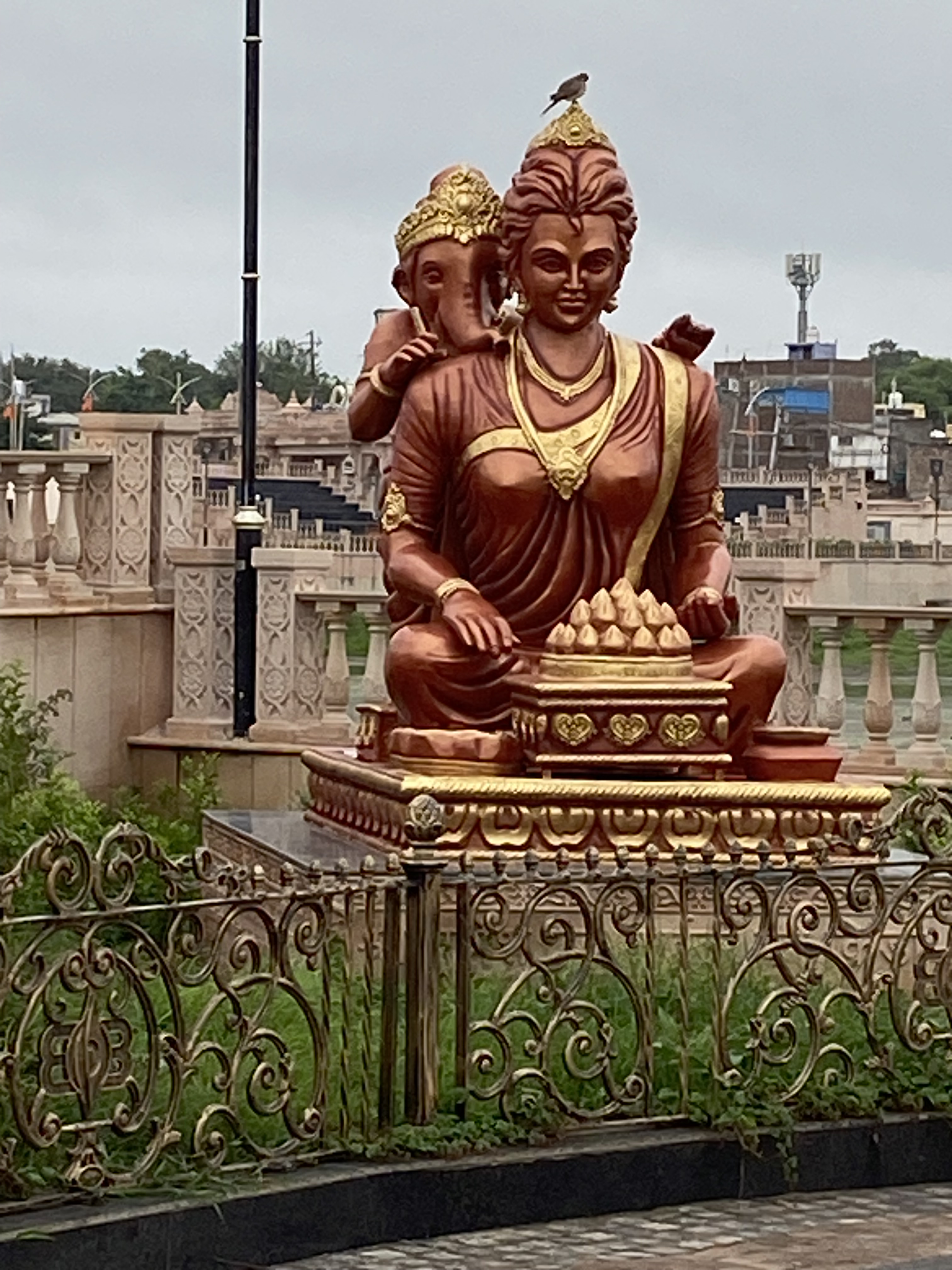
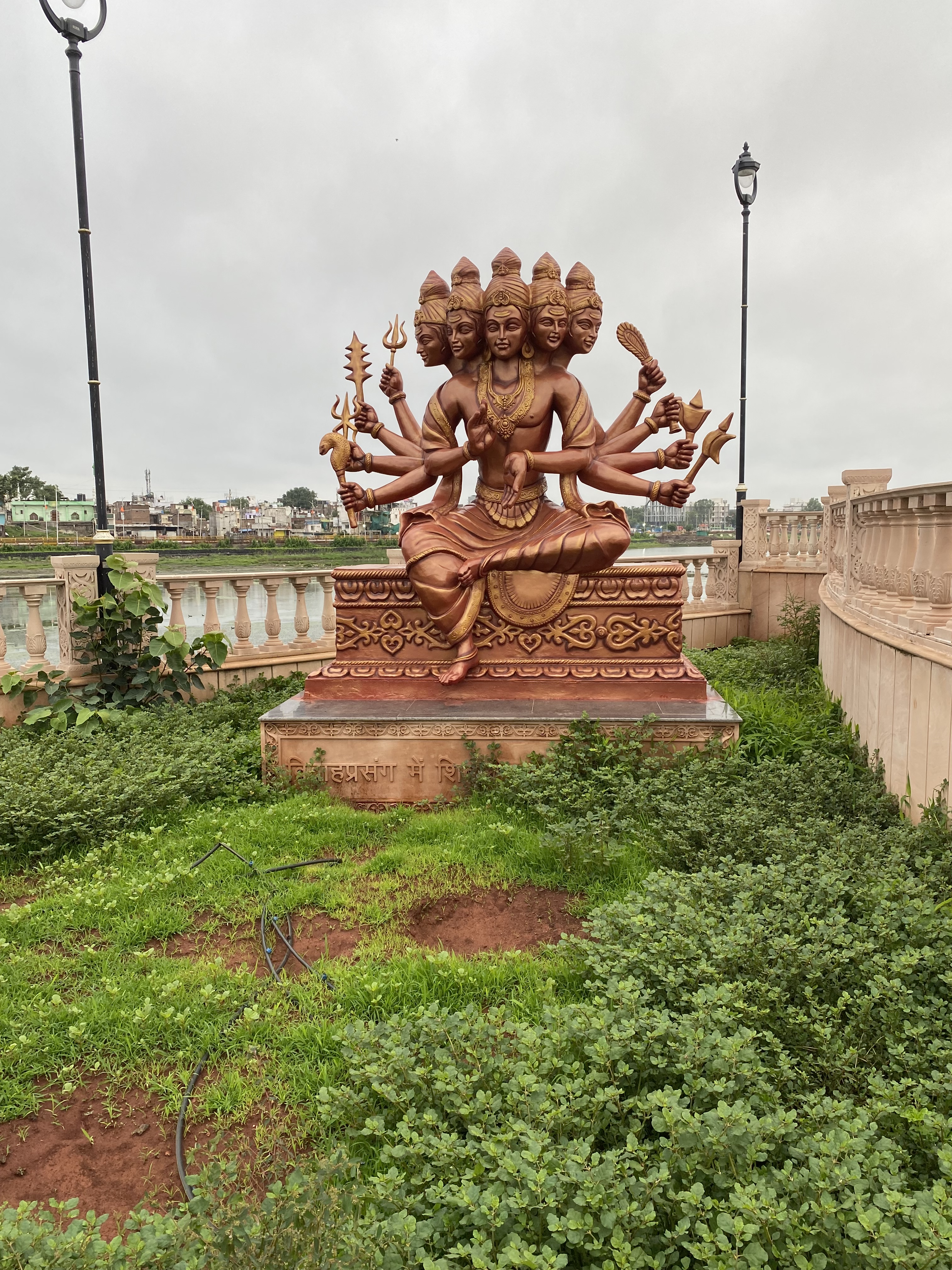
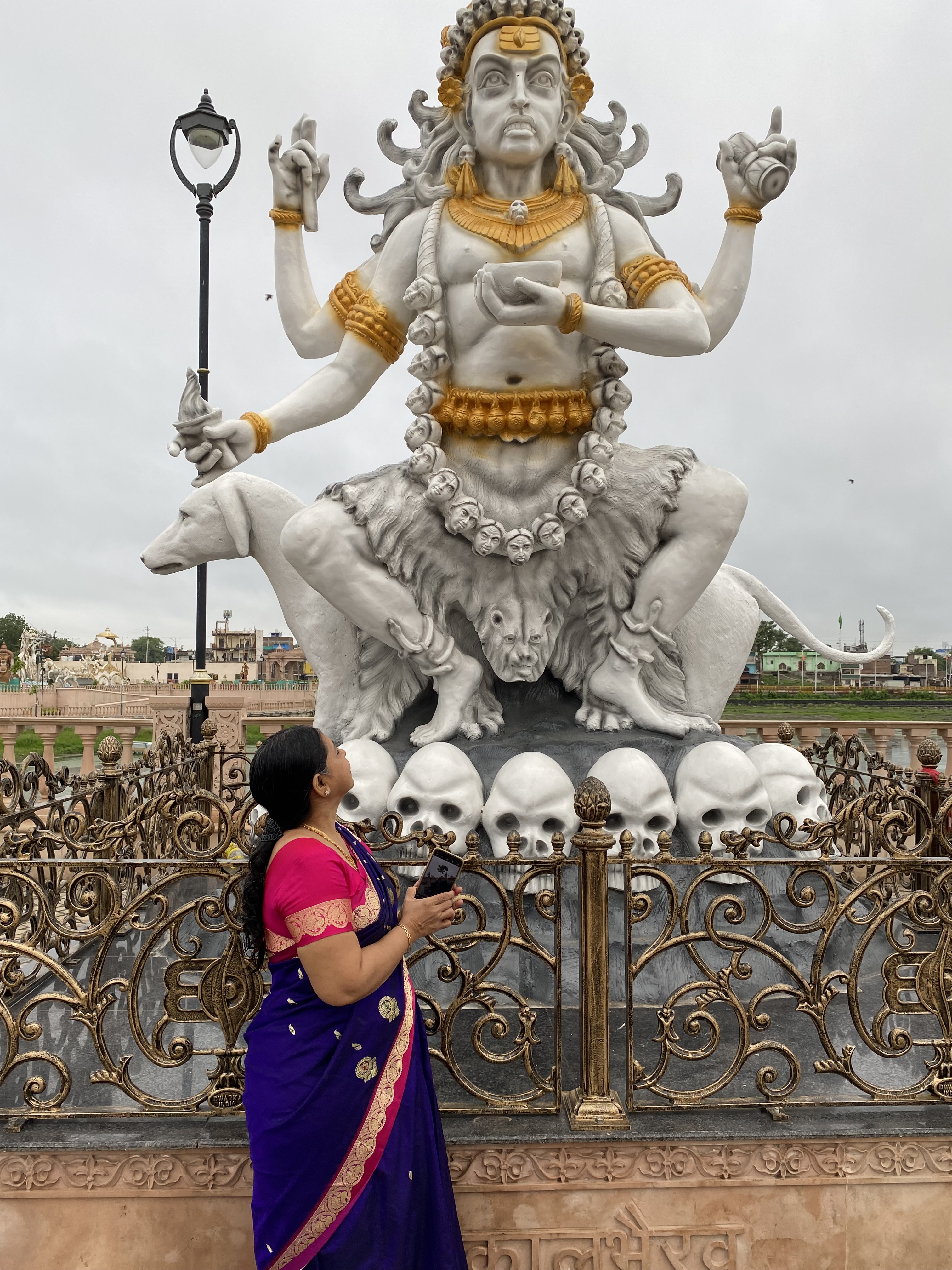
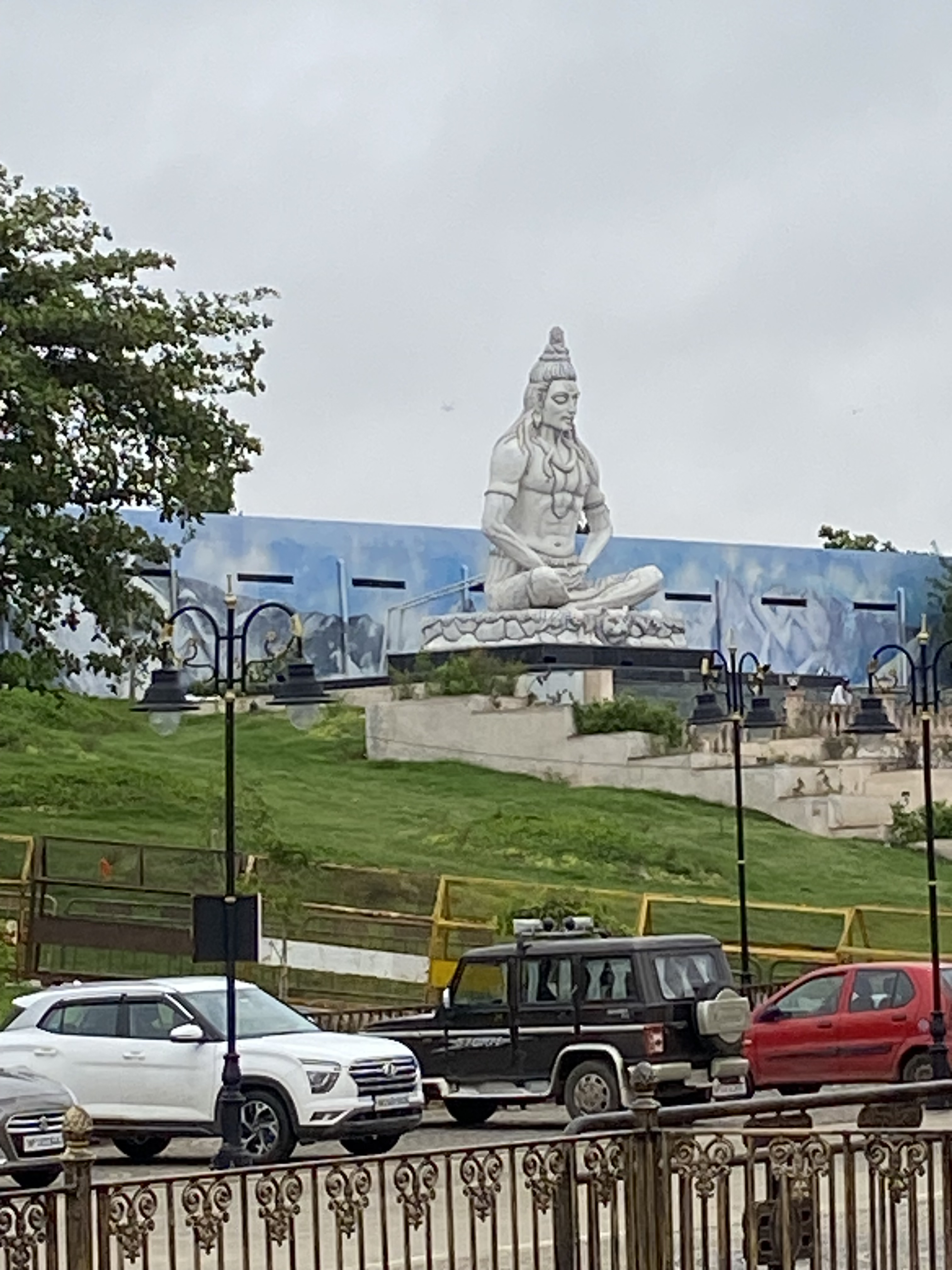
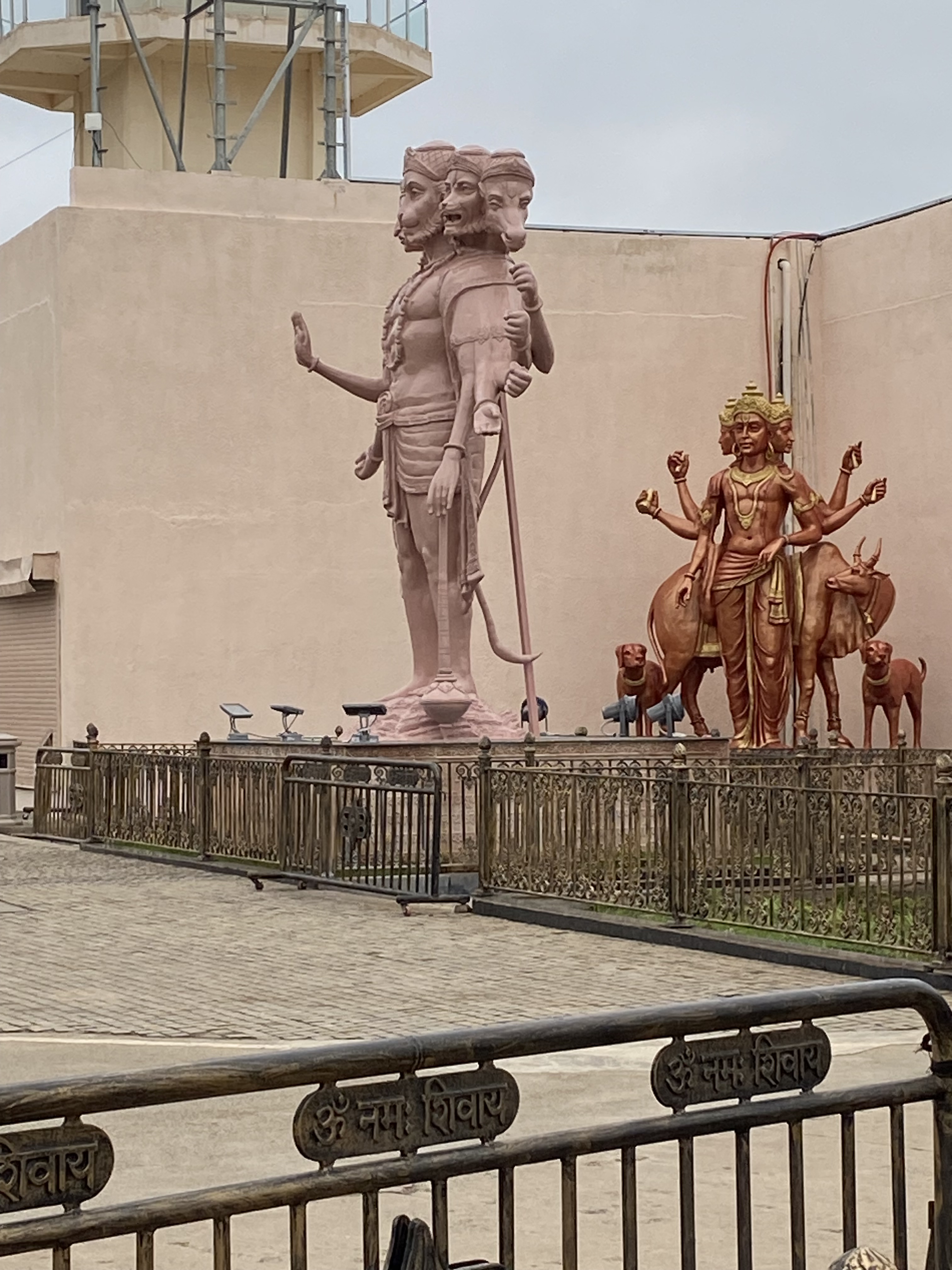
A birthday well spent; I thought as I drifted off to sleep.
Discover more from BalasBroadcast
Subscribe to get the latest posts sent to your email.
Thanks Bala for a nice summary of your visit to Ujjain. Lots of points of interest were nicely captured. In summary it serves as a nice one day guide to Ujjain.